Abstract Dissolved oxygen in the River Mesta (Bulgaria) a case study for qualitative modell
- 格式:pdf
- 大小:145.91 KB
- 文档页数:5
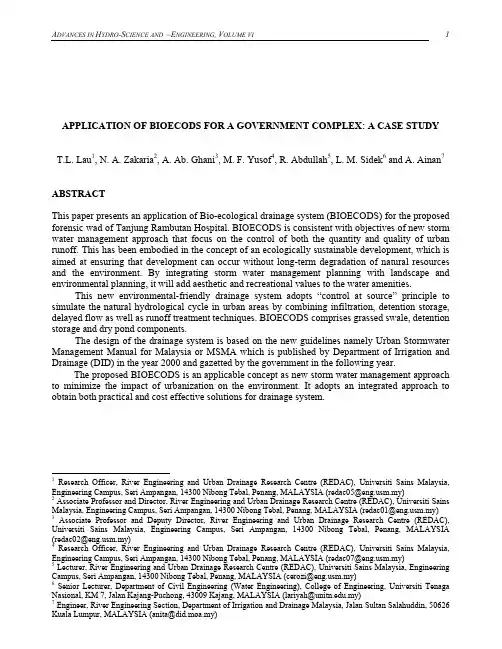
APPLICATION OF BIOECODS FOR A GOVERNMENT COMPLEX: A CASE STUDY T.L. Lau1, N. A. Zakaria2, A. Ab. Ghani3, M. F. Yusof4, R. Abdullah5, L. M. Sidek6 and A. Ainan7 ABSTRACTThis paper presents an application of Bio-ecological drainage system (BIOECODS) for the proposed forensic wad of Tanjung Rambutan Hospital. BIOECODS is consistent with objectives of new storm water management approach that focus on the control of both the quantity and quality of urban runoff. This has been embodied in the concept of an ecologically sustainable development, which is aimed at ensuring that development can occur without long-term degradation of natural resources and the environment. By integrating storm water management planning with landscape and environmental planning, it will add aesthetic and recreational values to the water amenities.This new environmental-friendly drainage system adopts “control at source” principle to simulate the natural hydrological cycle in urban areas by combining infiltration, detention storage, delayed flow as well as runoff treatment techniques. BIOECODS comprises grassed swale, detention storage and dry pond components.The design of the drainage system is based on the new guidelines namely Urban Stormwater Management Manual for Malaysia or MSMA which is published by Department of Irrigation and Drainage (DID) in the year 2000 and gazetted by the government in the following year.The proposed BIOECODS is an applicable concept as new storm water management approach to minimize the impact of urbanization on the environment. It adopts an integrated approach to obtain both practical and cost effective solutions for drainage system.1 Research Officer, River Engineering and Urban Drainage Research Centre (REDAC), Universiti Sains Malaysia, Engineering Campus, Seri Ampangan, 14300 Nibong Tebal, Penang, MALAYSIA (redac05@m.my)2 Associate Professor and Director, River Engineering and Urban Drainage Research Centre (REDAC), Universiti Sains Malaysia, Engineering Campus, Seri Ampangan, 14300 Nibong Tebal, Penang, MALAYSIA (redac01@m.my)3 Associate Professor and Deputy Director, River Engineering and Urban Drainage Research Centre (REDAC), Universiti Sains Malaysia, Engineering Campus, Seri Ampangan, 14300 Nibong Tebal, Penang, MALAYSIA (redac02@m.my)4 Research Officer, River Engineering and Urban Drainage Research Centre (REDAC), Universiti Sains Malaysia, Engineering Campus, Seri Ampangan, 14300 Nibong Tebal, Penang, MALAYSIA (redac07@m.my)5 Lecturer, River Engineering and Urban Drainage Research Centre (REDAC), Universiti Sains Malaysia, Engineering Campus, Seri Ampangan, 14300 Nibong Tebal, Penang, MALAYSIA (cerozi@m.my)6 Senior Lecturer, Department of Civil Engineering (Water Engineering), College of Engineering, Universiti Tenaga Nasional, KM 7, Jalan Kajang-Puchong, 43009 Kajang, MALAYSIA (lariyah@.my)7 Engineer, River Engineering Section, Department of Irrigation and Drainage Malaysia, Jalan Sultan Salahuddin, 50626 Kuala Lumpur, MALAYSIA (anita@did.moa.my)1. INTRODUCTIONIn order to realize Vision 2020, Malaysia is moving towards achieving a developed nation status by the year 2020. The Government of Malaysia via the Works Department is planning to construct a new building for the forensic wad of Tanjung Rambutan Hospital on the area of approximately 1.5 hectares in Ipoh, Perak Darul Ridzuan (Figure 1). In this project, the Government is planning to construct a drainage system that shall comply with the new guidelines which is published by Department of Irrigation and Drainage (DID) in the year 2000 and gazetted by the government in the following year, namely Urban Stormwater Management Manual for Malaysia or MSMA.2. PROJECT BACKGROUNDThis project consists of the construction of a single building, which includes administration unit, clinical unit, forensic block and wad. The project covers a catchment area of 1.51 hectares on medium soil type. More than 60 % of the total area has been developed into impervious area such as paved road and car park, sheltered walkway, and utilities other than the building. The origin of this area was cultivated field. The pre-development runoff was catered by roadside drain and other existing secondary drains before discharging to the nearest receiving water which is located at 200 meters at the downstream.3. DESIGN CRITERIA3.1 Design SystemThe design criteria for this project was based on Urban Stormwater Management Manual for Malaysia (DID, 2000). The manual recommends a major and minor system approach to be adopted for the planning and design of the proposed drainage system. The minor system is intended to collect and convey runoff from relatively frequent storm events to minimize inconvenience and nuisance flooding. The major system is intended to safely convey runoff not collected by the minor drainage system to waterway or rivers. However, the proposed drainage system for this project was designed to perform as both minor and major system due to the sensitivity of the project and the relatively small coverage area.3.2 Design StormThe intensity-duration-frequency (IDF) curves referred in the project are published by the Department of Irrigation and Drainage (DID) in the manual in polynomial expressions for the 35 main cities or towns in Malaysia as given in eq. 1.32))(ln())(ln()ln()ln(t d t c t b a I t R +++= (1)where, RI t = the average rainfall intensity (mm/hr) for ARI and duration t R = average return interval (years) t = duration (minutes)a to d are fitting constants dependent on ARI.Figure 1 Project Layout.Forensic BlockAdministration & Clinical UnitWadPerimeter SwaleEcological SwaleIpohFor duration between 5 and 30 minutes, the design rainfall depth P d for a short duration d (minutes) is given by,)(306030P P F P P D d −−= (2)where P 30, P 60 are the 30-minute and 60-minute duration rainfall depths respectively, obtained from the published design curves. F D is the adjustment factor for storm duration.The rainfall intensity for short duration storms is given by,dPI d = (3)where P d (mm) is rainfall depth in mm and d is duration in hours.3.3 Runoff EstimationThe Rational Formula is one of the most frequently used urban hydrology methods in Malaysia to computing stormwater flows from rainfall. It gives satisfactory results for small catchments up to 80 hectares only.The formula is:360..AI C Q t y y =(4)where,Q y = y year ARI peak flow (m 3/s) C = dimensionless runoff coefficient yI t = y year ARI average rainfall intensity over time of concentration, t c , (mm/hr) A = drainage area (ha)3.4 Runoff ConveyanceGrassed swale performs as a conveyance to serve the post-development runoff generated from the developed catchment area. The grassed swale is defined as grass earth channel combined with subsurface modules which enclosed within a permeable geotextile. The grassed swale acts as main conveyor on collecting and discharging runoff while the subsurface module acts as water quality treatment facility and assist in dewatering the base of grassed swale.The edge of a grassed swale is located 0.5m from road reserve or property boundary. The maximum depth of flow is designed not exceed 500mm with a minimum freeboard of 50mm above the design storm water level in the grassed swale. The average flow velocity is limited to 2m/s. The side slope of grassed swale is 1:4 (batter) and 1:50 (base). The overall conveyance is lined by axonophus compressus (cow grass) with a mild gradient of 0.2%. The grassed swale is designed by taken into consideration of peak flow attenuation, soil erosion and safety to the public.Grassed swale has the ability to reduce on-site peak flow rates by increasing the roughness of the channel and infiltration rates. These vegetated systems also provide runoff quality treatment by removing low concentrations and quantities of TSS, heavy metals, hydrocarbons and nutrients from stormwater. The vegetated systems remove pollutants by means of sedimentation, filtration, soil absorption and plant uptake.3.5 Runoff Quantity ControlOn-site detention (OSD) facility was selected as stromwater quantity control facilities for this project. On-site detention pond which contains of drypond and subsurface storage tank and module was designed to regulate the outflow discharge to pre-development discharge limit.The OSD sizing method for estimating Permissible Site Discharge (PSD) and Site Storage Requirement (SSR) is the Swinburne Method, developed at the Swinburne University of Technology in Melbourne, Australia. PSD is the maximum allowable post-development discharge from a site for the selected discharge design storm and is estimated on the basis that flows within the downstream stormwater drainage system will not be increased. The SSR is the total amount of storage required to ensure that the required PSD is not exceeded and the OSD facility does not overflow during the storage design storm ARI.For above-ground storage, the equation is used to calculate the PSD and SSR for the site are:242b a a PSD −−=(5)⎟⎟⎠⎞⎜⎜⎝⎛++⎟⎟⎠⎞⎜⎜⎝⎛=cs c a p c c a t t Q Q t t Q a 25.075.0333.04 (6)p a Q Q b 4= (7)where,t c = peak flow time of concentration from the top of the catchment to a designated outlet or pointof concern (minutes)t cs = peak flow time of concentration from the top of the catchment to the development site(minutes)Q a = the peak post-development flow from the site for the discharge design storm with a durationequal to t c (l/s)Q p = the peak pre-development flow from the site for the discharge design storm with a durationequal to t c (l/s)SSR = 0.06 t d (Q d – c – d)(8) ⎟⎟⎠⎞⎜⎜⎝⎛−=d Q PSD PSD c 459.01875.0 (9)dQ PSD d 2214.0= (10)where,t d = selected storm duration (minutes)Q d = the peak post-development flow from the site for a storm duration equal to t d (l/s)The critical storm duration that produces the largest required storage volume is different from the time of concentration used for peak flow estimation. The maximum storage volume must be determined for a range of storm duration as given in Figure 4.Figure 4 Typical Relationship of Storage Volume to Storm Duration (DID, 2000).4. PROPOSED DRAINAGE SYSTEMThe proposed drainage system which is known as Bio-ecological Drainage System (BIOECODS) for this project is consistent with objectives of new stormwater management approach which focus on the control of both the quantity and quality of urban runoff. This has been embodied in the concept of ecologically sustainable development which is aimed at ensuring that development can occur without long-term degradation of natural resources and the environment.4.1 Grassed SwaleThere are two types of grassed swale, i.e. perimeter swale and ecological swale (Figure 5). Perimeter swale is designed to cater any excess water from individual building whilst the flow from impermeable surface will directed to the grass swale. The perimeter swale is defined as grass earth channel combined with subsurface single module (Figure 6) which enclosed within a permeable geotextile.The flow from perimeter swale will be conveyed to ecological swale as main conveyor. The ecological swale is a grass earth channel combined with two numbers of single subsurface module which enclosed within a permeable geotextile.Figure 5 Typical Cross Section for Grassed Swale.Figure 6 Subsurface Module.4.2 Detention StorageThe excess stormwater is stored in the subsurface detention storage as illustrated in Figure 7. The storage modules have been designed to be places at the connecting points, junction and critical point of the system. The storage module is categorized into Type A and Type B with different storage capacity and can be arranged accordingly to suit site conditions. These detention storage are provided to reduce flows from the building, regulating flow velocity which cause the gravity settling of particulates and increase the infiltration process where all these mechanisms will control the quality and quantity of stormwater runoff.4.3 Dry PondThe excess stormwater is also stored in the dry pond constructed with a storage function. The dry pond (Figures 8 and 9) is a detention basin with the purpose to temporary store the stormwater runoff. This detention basin is design to store to the surface of 600mm of the excess rainfall under design average recurrent interval of 10-year and blend with the surrounding landscape. The outflow path is controlled by orifices in order to drain the dry pond system in less than 24 hours. Therefore, the quantity and quality of the runoff from developed areas can be maintained to be the same as pre-development condition.Dry pond is normally dry or empty when not in operation. It is utilised for multi-purpose use toincorporate recreational areas.Figure 7 Typical Cross Section for Detention Storage.Figure 8 Side View of Dry Pond.Figure 9 Plan View of Dry Pond.URBANISATIONOF5. IMPACTSThe land use changes from undeveloped to developed areas have caused approximately 50% increment of peak flow discharge from 0.36m3/s to 0.55m3/s on receiving water body. PSD and SSR are estimated as 0.34m3/s and 434m3 respectively. The required storage volume will be stored in dry pond and subsurface storage module.The primary outlet orifice is sized to discharge the PSD assuming free outlet conditions when the storage is full. Broad-crested weir is sized for the estimated major system ARI flow from the site for 50 year ARI.6. CONCLUSIONThe proposed BIOECODS is an applicable concept as new storm water management approach to minimize the impact of urbanization on the environment. It adopts an integrated approach to obtain both practical and cost effective solutions for drainage system.ACKNOWLEDGEMENTSThe authors would like to thank the Public Work Department and Ministry of Health, Malaysia for the support in implementing this project.REFERENCESDID. (2000). “Urban Stormwater Management Manual for Malaysia”, Department of Irrigation andDrainage.。
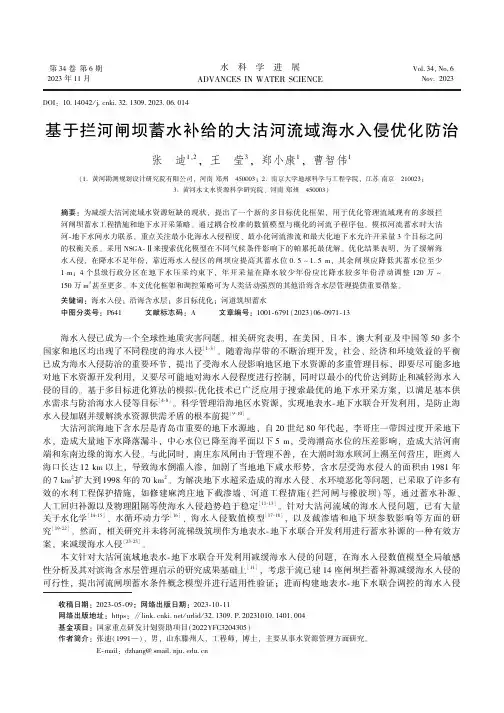
第34卷第6期2023年11月㊀㊀水科学进展ADVANCES IN WATER SCIENCE Vol.34,No.6Nov.2023DOI:10.14042/ki.32.1309.2023.06.014基于拦河闸坝蓄水补给的大沽河流域海水入侵优化防治张㊀迪1,2,王㊀莹3,郑小康1,曹智伟1(1.黄河勘测规划设计研究院有限公司,河南郑州㊀450003;2.南京大学地球科学与工程学院,江苏南京㊀210023;3.黄河水文水资源科学研究院,河南郑州㊀450003)摘要:为减缓大沽河流域水资源短缺的现状,提出了一个新的多目标优化框架,用于优化管理流域现有的多级拦河闸坝蓄水工程措施和地下水开采策略㊂通过耦合校准的数值模型与概化的河流子程序包,模拟河流蓄水时大沽河-地下水间水力联系,重点关注最小化海水入侵程度㊁最小化河流渗流和最大化地下水允许开采量3个目标之间的权衡关系㊂采用NSGA-Ⅱ来搜索优化模型在不同气候条件影响下的帕累托最优解㊂优化结果表明,为了缓解海水入侵,在降水不足年份,靠近海水入侵区的闸坝应提高其蓄水位0.5~1.5m,其余闸坝应降低其蓄水位至少1m;4个县级行政分区在地下水压采约束下,年开采量在降水较少年份应比降水较多年份浮动调整120万~150万m 3甚至更多㊂本文优化框架和调控策略可为人类活动强烈的其他沿海含水层管理提供重要借鉴㊂关键词:海水入侵;沿海含水层;多目标优化;河道筑坝蓄水中图分类号:P641㊀㊀㊀文献标志码:A㊀㊀㊀文章编号:1001-6791(2023)06-0971-13收稿日期:2023-05-09;网络出版日期:2023-10-11网络出版地址:https :ʊ /urlid /32.1309.P.20231010.1401.004基金项目:国家重点研发计划资助项目(2022YFC3204305)作者简介:张迪(1991 ),男,山东滕州人,工程师,博士,主要从事水资源管理方面研究㊂E-mail:dzhang@海水入侵已成为一个全球性地质灾害问题㊂相关研究表明,在美国㊁日本㊁澳大利亚及中国等50多个国家和地区均出现了不同程度的海水入侵[1-3]㊂随着海岸带的不断治理开发,社会㊁经济和环境效益的平衡已成为海水入侵防治的重要环节,提出了受海水入侵影响地区地下水资源的多重管理目标,即要尽可能多地对地下水资源开发利用,又要尽可能地对海水入侵程度进行控制,同时以最小的代价达到防止和减轻海水入侵的目的㊂基于多目标进化算法的模拟-优化技术已广泛应用于搜索最优的地下水开采方案,以满足基本供水需求与防治海水入侵等目标[4-8]㊂科学管理沿海地区水资源,实现地表水-地下水联合开发利用,是防止海水入侵加剧并缓解淡水资源供需矛盾的根本前提[9-10]㊂大沽河滨海地下含水层是青岛市重要的地下水源地,自20世纪80年代起,李哥庄一带因过度开采地下水,造成大量地下水降落漏斗,中心水位已降至海平面以下5m,受海潮高水位的压差影响,造成大沽河南端和东南边缘的海水入侵㊂与此同时,南庄东风闸由于管理不善,在大潮时海水顺河上溯至何营庄,距离入海口长达12km 以上,导致海水倒灌入渗,加剧了当地地下咸水形势,含水层受海水侵入的面积由1981年的7km 2扩大到1998年的70km 2㊂为解决地下水超采造成的海水入侵㊁水环境恶化等问题,已采取了许多有效的水利工程保护措施,如修建麻湾庄地下截渗墙㊁河道工程措施(拦河闸与橡胶坝)等,通过蓄水补源㊁人工回归补源以及物理阻隔等使海水入侵趋势趋于稳定[11-13]㊂针对大沽河流域的海水入侵问题,已有大量关于水化学[14-15]㊁水循环动力学[16]㊁海水入侵数值模型[17-18],以及截渗墙和地下坝参数影响等方面的研究[19-22]㊂然而,相关研究并未将河流梯级筑坝作为地表水-地下水联合开发利用进行蓄水补源的一种有效方案,来减缓海水入侵[23-25]㊂本文针对大沽河流域地表水-地下水联合开发利用减缓海水入侵的问题,在海水入侵数值模型全局敏感性分析及其对滨海含水层管理启示的研究成果基础上[11],考虑干流已建14座闸坝拦蓄补源减缓海水入侵的可行性,提出河流闸坝蓄水条件概念模型并进行适用性验证;进而构建地表水-地下水联合调控的海水入侵972㊀水科学进展第34卷㊀优化框架并对气候变化条件下海水入侵防控策略进行分析,为沿海地下水系统的优化管理提供科学决策依据和技术支撑㊂1㊀研究区简介1.1㊀区域概况大沽河流域滨海含水层是青岛市的重要供水水源地,辖即墨市㊁莱西市㊁平度市和胶州市4个县级行政区,面积约613km2㊂研究区多年平均降水量为570.23mm㊁蒸发量为964.74mm,东侧紧临桃源河,含水层在此处尖灭,桃源河与研究区内地下水无直接水力联系㊂区内大沽河干流建有拦河闸坝14座,沿干流方向依次为许村㊁江家庄㊁庄头㊁程家小里㊁孙洲庄㊁沙湾庄㊁袁家庄㊁移风㊁崖头㊁大坝㊁岔河㊁引黄闸㊁贾疃和南庄,干流河道长179.9km㊂研究区土地利用类型主要包括旱地(460.68km2)㊁居住地(97.75km2)㊁商服建设用地(7km2)㊁河流(35.5km2)㊁坑塘(8.12km2)㊁林地(2.17km2)和未利用土地(4.78km2);地下水开采主要是农业灌溉及工业-生活开采(图1)㊂图1㊀大沽河研究区域概况Fig.1Overview map of Dagu River basin㊀第6期张迪,等:基于拦河闸坝蓄水补给的大沽河流域海水入侵优化防治973㊀研究区出露的地层主要有第四系松散地层及下伏的中生代白垩系王氏组(K2w),第三系为隐伏地层㊂第四系地层广泛分布于区内现代河谷两侧㊁山前㊁河流入海处及准平原地区,为更新-全新统冲积㊁洪积㊁冲洪积㊁残坡积㊁海积㊁海陆交互堆积及人工堆积等松散堆积层㊂其中,冲积和冲洪积层最具供水意义,厚度一般为3~20m,多具双层结构,上部为黏质砂土及砂质黏土,下部为不同粒径的砂及砂砾石层,其中有泥质夹层,边缘地带有坡积层楔入,结构较为复杂㊂河流愈小,砂层愈薄,分选性差,相变大;上游为花岗岩分布区,砂层颗粒较粗;在河口附近及近海洼地,冲积层中常有海相沉积夹层,岩性为淤泥㊁淤泥质黏土㊁淤泥质砂等,厚度一般小于5m㊂1.2㊀水文地质概念模型大沽河滨海含水层储水介质由渗透性不同的2个地层组成,上部为渗透性较低的砂质黏土,地下水主要赋存于下部渗透性较大的砂砾石中,沿大沽河东西侧呈带状分布,遵循达西定律㊂地下水流数值模型的边界条件概化参见文献[11],对于溶质运移模型,海水入侵区属于基岩海岸带,海水沿大沽河河道上溯,将南部边界视为给定浓度边界,依据2010年典型区水质采样数据赋值,东西边界视为零通量边界,北界视为给定水头边界㊂地下水位和水质监测井没有分层,但部分或完全穿透含水层㊂具体边界条件及初始浓度如图2所示㊂图2㊀研究区水文地质概念模型Fig.2Hydrogeological conceptual model of the study area2㊀研究方法2.1㊀河流筑坝蓄水概念模型过去几年,由于降水偏少,研究区内的拦河闸坝并没有进行科学规范的蓄水管理㊂但自2020年以来,由于降水充足,应考虑对其进行优化管理,实现沿海含水层地表水和地下水的联合利用,河流筑坝蓄水是满足淡水需求同时能缓解海水入侵的可行选择㊂974㊀水科学进展第34卷㊀拦河闸和橡胶坝均为可控建筑物,需根据调度规则设置不同的启闭状态及触发条件,其过流方式分为溢流型和底流型㊂溢流型相当于一个顶高程可变的堰,沙湾庄橡胶坝㊁岔河橡胶坝等可概化为溢流型;底流型相当于一个垂直闸门,孙洲庄拦河闸㊁移风拦河闸等可概化为底流型㊂水工建筑物的调度运行是根据控制点的值来确定闸门的高程或流量,如图3所示是闸坝未蓄水和蓄水时的2种不同状态,拦河闸门开启以及橡胶坝未充气时,河流处于未蓄水状态;反之拦河闸门关闭以及橡胶坝充气时,河流进行蓄水㊂图3㊀研究区内拦河闸坝蓄水与否河道剖面示意Fig.3Two different states of the river damming system河流补给地下水或排泄地下水由河流与地下水两者之间的水力梯度所决定㊂使用MODFLOW河流子程序包来模拟地表水与地下水系统间的水量交换㊂与MODFLOW保持一致的是,在每次计算迭代开始时,将代表河流渗流的项添加到包含河流河段的每个单元的流动方程中;不同的是,在拦河闸坝处于蓄水状态时,每次迭代时河段渗流长度的选取,由闸坝上游也就是闸坝后的最新河水位值与所在计算单元的河床底板高程值比较判断得到㊂这个过程在每次迭代的开始时完成,判断所用的地下水水头值是来自前一次计算迭代的值㊂具体数学控制方程描述见文献[26]㊂2.2㊀海水入侵模型的适用性验证基于已有海水入侵数值模拟结果得出[11],在降水量较少的年份,麻湾庄截渗墙南北两侧地下水位低于截渗墙顶部高程(0m)时,南北两侧处于2个相对独立的地下水流子系统,流场和浓度场均呈现出截渗墙南北两侧没有水力联系㊂为了验证模型在降水量较多的年份模拟结果的准确性,在2010-01-01/2018-06-01模型校验参数的基础上,结合河流筑坝蓄水条件概念模型以及后期监测数据和不同闸坝蓄水位的收集将模拟期更新至2021-01-01,对模型的适用性进行验证,评价所构建的海水入侵模型在不同降水条件下对地下水流场及浓度场的刻画㊂模型精度采用3个性能标准来评价:相关系数(R)㊁均方根误差(E RMS)和平均绝对误差㊀第6期张迪,等:基于拦河闸坝蓄水补给的大沽河流域海水入侵优化防治975㊀(E MA)㊂如图4所示,整个模拟期内全区地下水流模型的R为0.98,E RMS为1.06m,E MA为0.84m㊂选取的典型地下水位观测井在整个模拟期内,模拟水位与实测水位的变化趋势一致㊂图4㊀地下水流数值拟合结果Fig.4Comparison of the calculated and observed groundwater levels at the observation well locations如图5所示,在整个模拟期内,研究区海水入侵数值模型的R为0.91,E RMS为89.49mg/L,E MA为73.89mg/L㊂选取的典型观测井在整个模拟期内,模拟Cl-质量浓度变化与实测Cl-质量浓度的变化趋势基本一致,模拟结束时刻的Cl-质量浓度场分布见图6㊂从图6中可以看出,截渗墙北侧及下游东南侧的海水入侵程度较降水量偏少的2018年明显改善,海水入侵面积由2018年6月的53.84km2缩减为51.13km2㊂由于2020年异常充足的降水入渗及河流侧向补给使得地下水位抬升显著,形成水力屏障,在天然地下水的排泄作用下向后自然驱退海水入侵,再次验证了所构建的海水入侵模型可以准确地刻画不同降雨作用下的浓度场,进一步证实所构建的海水入侵模型能较好地刻画2010年至2020年的海水入侵物理过程;以及通过拦河闸与橡胶坝截获地表水体,可以增加地下水补给来源,抬升地表水水位以补给地下水,进而增加地下水流场水力梯度,达到增加地下水向海排泄量的作用,减缓海水入侵㊂图5㊀海水入侵数值拟合结果Fig.5Comparison of the calculated and observed Cl-concentration at the observation well locations976㊀水科学进展第34卷㊀图6㊀模拟结束时刻(2021-01-01)研究区Cl-质量浓度场分布Fig.6Spatial distribution of the simulated Cl-in the main modeled aquifer at the end of the simulation period(1January2021) 2.3㊀多目标优化问题求解算法由于非支配排序遗传算法(NSGA)的非支配排序在时间上的复杂度为O(MN3)(M为目标函数个数,N 为种群大小),当优化问题的种群规模较大时会导致排序的速度较为缓慢,同时NSGA利用共享函数来达到解的均匀分布,这是一种依赖于共享参数σshare的选择,其复杂度高达O(N2)㊂为此,采用带精英策略的快速非支配排序算法NSGA-Ⅱ[27],其在时间上的复杂度为O(M(2N)2),排序速度相比于NSGA的O(MN3)有较大幅度的提升㊂而且,NSGA-Ⅱ采用精英策略,保证不放弃寻找到的最优解,搜索性能从而提高,此外重新定义拥挤距离代替共享参数㊂NSGA-Ⅱ算法具体流程概述如下:(1)采用拉丁超立方抽样生成1个数量为N的随机初始种群并进行非支配排序,然后利用遗传算法的选择㊁交叉和变异生成第1代子代种群;(2)从第2代开始,合并父代与子代种群得到新父种群后进行非支配排序及拥挤度计算,按照非支配排序和拥挤度大小选取合适个体组成新父种群;(3)对新父种群进行选择㊁交叉㊁变异得到新的子代种群;重复执行上述过程,直到程序判别终止㊂2.4㊀控制海水入侵的地下水优化管理框架当考虑利用现有闸坝蓄水补源减缓海水入侵时,坝后蓄水高度可以调整挡板来人为控制,但通常只是决策者经验判断,缺乏科学的调控策略㊂决策者通常倾向于尽可能地增加地表水对地下水的补给去减缓海水入侵程度,但这与满足更多的地表水引水灌溉的现实需求相矛盾㊂决策者不知道最有效的河流蓄水高度,需要提出多个目标对地表水引水灌溉和地下水补给进行权衡,以缓解海水入侵㊂此外,为了有效控制海水入侵程度,山东省政府对地下水资源的开采实行了严格压采措施㊂然而,这种限制与经济社会发展对水资源不断增加的需求相矛盾㊂为了在不同气候条件下实现含水层系统相互矛盾目标(地下水开采量㊁河流入渗补给量和海水入侵程度)之间更好的权衡,构建控制海水入侵的地下水优化管理框架,以达到研究区合理的水资源需求与减缓海水入侵的管理目标㊂优化管理框架包括数值模拟模型模块㊁目标函数评价模块和优化求解模块㊂其中,模拟模型模块是利用变密度流模拟程序(SEAWAT)对海水入侵进行动态模拟;目标函数评价模块包括一系列的管理目标(最小化㊀第6期张迪,等:基于拦河闸坝蓄水补给的大沽河流域海水入侵优化防治977㊀管理期末含水层溶质质量比㊁最小化河流入渗补给量以及最大化地下水开采量)和一系列的约束条件(14个拦河闸坝对应的不同蓄水高度㊁海水入侵面积约束㊁滨海地下水需水量约束);优化求解模块采用NSGA-Ⅱ算法进行优化计算㊂数值模拟模型模块通过个体决策变量与优化计算模块相耦合,目标函数评价模块通过个体状态变量与数值模拟模型模块相耦合,优化求解模块读取目标函数评价模块计算的目标函数值使两者相联结㊂在模拟-优化的框架下,通过重复调用数值模型输出状态变量(浓度等)计算目标函数与判断约束条件㊂相应的目标函数和约束条件的数学表达式为:min J1=M end/M ini(1)max J2=ðN n=1ðT t=1Q n,t(2)min J3=ðN n=1ðT t=1S n,t(3)H minɤH n,tɤH max㊀㊀n=1,2, ,N;t=1,2, ,T(4)ðI i=1ðT t=1Q i,tɤQ cons㊀㊀i=1,2, ,I;t=1,2, ,T(5)S endɤS ini㊀㊀㊀㊀S=ðN g g=1P g A g(C gȡ250mg/L,P g=1,P g=0)(6)式中:J1为第1个目标,表示管理期末主含水层中溶质质量占初始状态的百分比;M ini和M end分别为管理期开始和结束时主含水层中的总溶质质量,其中管理期共5a;J2为第2个目标,表示年均地下水开采总量;Q i,t为第t个管理期第i个生产井的抽水量;J3为第3个目标,表示年均河流入渗补给地下水量;S n,t 为第t个管理期第n个河段的河流入渗量;H n,t为第t个管理期第n个河段的闸坝上游一侧水头;H min㊁H max分别为每个闸坝的最低和最高蓄水位;Q cons为地下水年开采总量不能超过的规定红线值,即现状年均地下水开采量的80%;S end为管理期5a结束时海水入侵面积;S ini为2021-01-01初始状态海水入侵面积; g为网格编号;N g为网格总数;P g表示所有模型网格的Cl-质量浓度(C g)是否超过允许浓度250mg/L, P g=1则为是,P g=0则为否;A g为网格面积㊂管理期结束时海水入侵面积超过规定值,表明违背了海水入侵约束条件的范围,也就是说,从决策可行的角度来看,管理方案是不被采纳的㊂优化的地下水开采量为年地下水总开采量按比例分配至每个应力期㊂多目标优化算法参数设置为种群大小200,代数100,交叉概率0.8,突变概率0.05㊂决策变量的取值范围见表1㊂表1㊀输入管理模型的决策变量取值范围Table1Ranges of decision variables input to the management model978㊀水科学进展第34卷㊀3㊀气候变化条件下控制海水入侵的地下水优化管理3.1㊀降水频率预测方案基于皮尔逊Ⅲ型频率曲线对从国家气象信息中心获得的大沽河研究区过去30a(1989 2018年)的降水数据进行频率分析,得出了分别对应于特丰水年㊁偏丰水年㊁平水年㊁偏枯水年和特枯水年的5种不同降水场景㊂这里,特丰水年㊁偏丰水年㊁平水年㊁偏枯水年和特枯水年的气候条件对应于降水频率曲线的输出分别用S1 S5对应表示,其频率分别为12.5%㊁37.5%㊁50.0%㊁62.5%和87.5%㊂变差系数(C v)和偏态系数(C s)分别设定为0.3和0.75㊂S1 S5的年降水量分别为856.0㊁749.6㊁614.4㊁494.0和424.6mm㊂3.2㊀三维多目标优化结果与管理启示NSGA-Ⅱ在规定的100代时被终止,对所有获得的解进行Pareto排序㊂与S1 S5的不同气候情景相对应的Pareto前沿分别由955㊁889㊁1153㊁1006和995个最优方案组成,它们定义了海水入侵程度㊁地下水开采总量和河流入渗补给量3个目标之间的相互权衡㊂在每个主轴上,黑色箭头表示每个目标的优化方向(备选方案)㊂图7表明,所有的3维Pareto最优解都覆盖了广泛的权衡面,其中,0.8251<J1<0.8902, 4730万m3<J2<5650万m3,970万m3<J3<6380万m3㊂优化前对应于当前方案(S0)的3个目标的值分别为1㊁7100万m3㊁3880万m3㊂在干旱年份,降水带来的入渗补给量不断减少,导致地下水位呈下降趋势,海水和淡水的压力差增大,海水入侵程度严重,而在降水较多的年份则相反㊂值得注意的是,在河流对地下水渗流补给最小化㊁地下水开采总量最大化的前提下,与初始状态相比,S1 S5所对应的海水入侵程度均得到有效缓解㊂此外,从图8中可以看出,地下水开采量不能超过当地政府规定的80%的现状红线㊂同时,与现行方案相比,河水的渗漏量较少,这意味着有更多的地表水可供灌溉和生活使用,推动了地下水开采成本的节约㊂特别是,当地农民目前每立方米需要支付0.12~0.33元(青岛市物价局2017年数据)来提取地下水用于农业灌溉㊂因此,目前的管理方案显然是不理想的,需要通过多目标优化框架寻求权衡解㊂在多数情况下,从由数百个最优方案组成的大型方案集中选择首选方案对决策者来说是困难的,通常取决于决策者的优先权或效用㊂从图9(a)可以看出,在不同的气候情景下,通过多目标优化管理得到的坝后水头与现行方案相比有了很大的变化㊂为了缓解海水入侵,在降水不足的年份,靠近海水入侵区的闸坝至少要将其蓄水位提高0.5~1.5m,而其他闸坝则需将其蓄水位至少降低1m㊂南庄橡胶坝和贾疃橡胶坝在5种不同的气候情景下都呈现出将坝后水位提高到挡板最高点的必要性,即坝后河水水位抬升至尽可能高度;对于岔河橡胶坝和引黄闸,在降水量不足的年份,由于入渗补给的减少,为了尽量减少海水入侵程度,蓄水位应该比降水量充足的年份提高;对于大坝橡胶坝及其北部的其余闸坝,由于距离海水入侵区域较远,对海水入侵过程不敏感,相对于目前的方案,应降低蓄水位,以减少河流对地下水的渗流补给,进而满足从现有地表水中引出更多灌溉和生活用水的需要㊂从所选方案1㊁4㊁7㊁10㊁13相对应的河流渗流情况表明,在干旱年份,需要更多的河流渗流补给来缓解海水入侵,然而,这实际上是不可能的,因此有必要实行严格的节水措施㊂图9(b)表明,在限制地下水开采的约束条件下,4个县级行政分区的地下水年开采量在降水较少的年份应比降水较多的年份浮动调整120万~150万m3甚至更多㊂由于胶州地区位于海水入侵典型区,对海水入侵过程的影响较大,因此,降水较少的年份与降水较多的年份相比,胶州地区的地下水开采量应有所下降;在5种不同的降水情景下,平度地区在不超过红线的情况下,可以尽可能多地抽取地下水来满足经济和社会发展,即地下水抽取量可以达到2.4ˑ107m3/a;另外,对于即墨和莱西地区,在降水量相对较少的年份,㊀第6期张迪,等:基于拦河闸坝蓄水补给的大沽河流域海水入侵优化防治979㊀图7㊀研究区5种不同降水场景3个目标之间权衡的Pareto前沿Fig.7Pareto-front defining the tradeoffs among three objectives under five different precipitation scenarios in the study area可以适度增加地下水开采量,不仅可以满足胶州地区需要大幅减少开采量的海水入侵防控措施,还可以满足地下水开采总量与研究区的地下水需求相一致的目标㊂总之,政策制定者必须认识到在一系列复杂的限制条件下,地表水和地下水的联合利用对于控制海水入侵的权衡策略㊂980㊀水科学进展第34卷㊀图8㊀研究区5种不同的降水场景对应的典型方案Fig.8Typical scenarios corresponding to five different precipitation scenarios in the study area图9㊀5种不同降水场景下各闸坝蓄水位和4个县级行政开采区地下水开采总量的变化Fig.9Variations of impoundment-water head behind each dam and total pumping rates from four county-level administrative subdomains under five different precipitation scenarios㊀第6期张迪,等:基于拦河闸坝蓄水补给的大沽河流域海水入侵优化防治981㊀4㊀结㊀㊀论本文结合国内外研究成果与资料分析,在大沽河流域滨海含水层建立了考虑河道工程措施的变密度地下水数值模拟及优化管理模型,为沿海地区地下水资源的优化配置及海水入侵防控提供理论框架与科学决策依据,主要结论有:(1)该模型能够刻画研究区含水层咸淡水过渡带在不同降水条件下海水入侵的物理过程㊂(2)目前的管理方案是次优的,利用NSGA-Ⅱ求解的最佳权衡策略可以实现最佳效用㊂(3)南庄橡胶坝和贾疃橡胶坝需将坝后蓄水位抬升至隔水挡板的最高点,岔河橡胶坝和引黄闸在降水量不足年份应比降水量充足年份蓄水位抬高,大坝及其北部其余闸坝均应降低蓄水位㊂(4)胶州地区在降水量较少年份应减少地下水开采;平度地区在不超过压采量红线的情况下,应尽可能多地抽取地下水;即墨和莱西地区,在降水量相对较少的年份,可以适度增加开采量㊂参考文献:[1]郭占荣,黄奕普.海水入侵问题研究综述[J].水文,2003,23(3):10-15,9.(GUO Z R,HUANG Y prehensive study on seawater intrusion[J].Hydrology,2003,23(3):10-15,9.(in Chinese))[2]WERNER A D,BAKKER M,POST V E A,et al.Seawater intrusion processes,investigation and management:recent advances and future challenges[J].Advances in Water Resources,2013,51:3-26.[3]KINZELBACH W,BAUER P,SIEGFRIED T,et al.Sustainable groundwater management:problems and scientific tools[J]. Episodes,2003,26(4):279-284.[4]WANG Z C,YANG Y,WU J F,et al.Multi-objective optimization of the coastal groundwater abstraction for striking the balance among conflicts of resource-environment-economy in Longkou City,China[J].Water Research,2022,211:118045. [5]高玉芳,陈耀登,张展羽.沿海地区地下水模拟优化管理模型[J].水科学进展,2010,21(5):622-627.(GAO Y F, CHEN Y D,ZHANG Z Y.Simulation-optimization modeling for groundwater management in coastal areas[J].Advances in Water Science,2010,21(5):622-627.(in Chinese))[6]林锦,郑春苗,吴剑锋,等.基于遗传算法的变密度条件下地下水模拟优化模型[J].水利学报,2007,38(10):1236-1244.(LIN J,ZHENG C M,WU J F,et al.Ground water simulation optimization model based on genetic algorithm under varia-ble density conditions[J].Journal of Hydraulic Engineering,2007,38(10):1236-1244.(in Chinese))[7]YANG Y,SONG J,SIMMONS C T,et al.A conjunctive management framework for the optimal design of pumping and injection strategies to mitigate seawater intrusion[J].Journal of Environmental Management,2021,282:111964.[8]LUO Q K,WU J F,YANG Y,et al.Optimal design of groundwater remediation system using a probabilistic multi-objective fast harmony search algorithm under uncertainty[J].Journal of Hydrology,2014,519:3305-3315.[9]吴吉春,吴永祥,林锦,等.黄渤海沿海地区地下水管理与海水入侵防治研究[J].中国环境管理,2018,10(2):91-92.(WU J C,WU Y X,LIN J,et al.Study on the groundwater management and seawater intrusion prevention in the coastal are-as of the Bohai Sea and the Yellow Sea[J].Chinese Journal of Environmental Management,2018,10(2):91-92.(in Chi-nese))[10]陈飞,徐翔宇,羊艳,等.中国地下水资源演变趋势及影响因素分析[J].水科学进展,2020,31(6):811-819.(CHEN F,XU X Y,YANG Y,et al.Investigation on the evolution trends and influencing factors of groundwater resources in China[J].Advances in Water Science,2020,31(6):811-819.(in Chinese))[11]ZHANG D,YANG Y,WU J F,et al.Global sensitivity analysis on a numerical model of seawater intrusion and its implicationsfor coastal aquifer management:a case study in Dagu River basin,Jiaozhou Bay,China[J].Hydrogeology Journal,2020,28(7):2543-2557.[12]ZHENG T Y,ZHENG X L,CHANG Q P,et al.Timescale and effectiveness of residual saltwater desalinization behind subsur-。
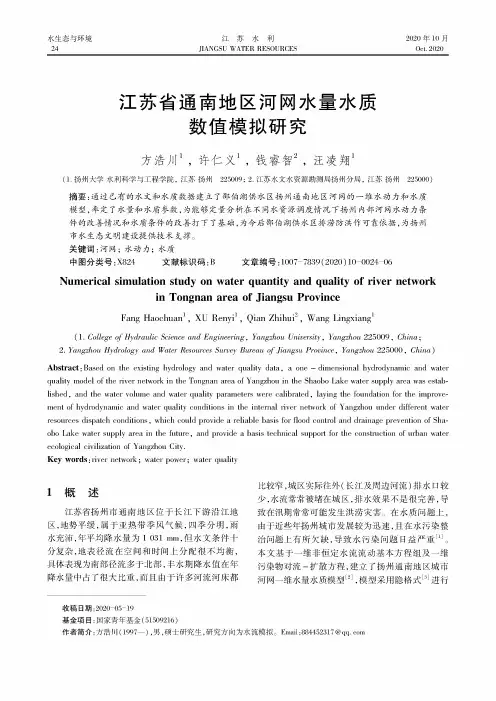
水生态与环境24江苏水利JIANGSUWATERRESOURCES2020年10月Oct.2020江苏省通南地区河网水量水质数值模拟研究方浩川1,许仁义1,钱睿智2,汪凌翔1(1.扬州大学水利科学与工程学院,江苏扬州225009;2.江苏水文水资源勘测局扬州分局,江苏扬州225000)摘要:通过已有的水文和水质数据建立了邵伯湖供水区扬州通南地区河网的一维水动力和水质模型,率定了水量和水质参数,为能够定量分析在不同水资源调度情况下扬州内部河网水动力条件的改善情况和水质条件的改善打下了基础,为今后邵伯湖供水区排涝防洪作可靠依据,为扬州市水生态文明建设提供技术支撑。
关键词:河网;水动力;水质中图分类号:X824文献标识码:B文章编号:1007-7839(2020)10-0024-06Numerical simulation strdy on water quantity and quality of river networkin Tongnan area of Jiangse ProvinccFang Haochuan1,XU RenyO,Qian Zhihui2,Wang Lingxiang1(1.Cofegs of Hydraulie Science and Engineering,Yangzhow University,Yangzhow225009,China;2.Yangzhow Hydrology and Water Resources Suos Bureau of Jiangsu Province,Yangzhow225000,China) Abstract:Based on the existing hydelogy and wateo quality data,a one—dniiensional hydrodynamtc and wateo quality model of the riveo network in the Tongnan ard of Yangzhou in the Shaobo Lake wateo supply ard was estab-oohed,and thewateeeooumeand wateequaootypaeameteeGweeecaoobeated,oayongthetoundatoon toetheompeoee-mentothydeodynamocand wateequaootycondotoonGon theonteenaoeoeeenetwoek otYangehou undeedo t eeentwatee eeGoueceGdopatch condotoonG,whoch couod peoeodeaeeooaboebaGotoetoood conteooand deaonagepeeeentoon otSha-oboLakewateeGuppoyaeeaon thetutuee,and peoeodeabaGotechnocaoGuppoettoetheconGteuctoon otueban watee ecooogocaocoeoooeatoon otYangehou Coty.Key wo5dt:eoeeenetwoek;wateepowee;wateequaooty1概述江苏省扬州市通南地区位于长江下游沿江地区,地势平缓,属于亚热带季风气候,四季分明,雨水充沛,年平均降水量为1031mm,但水文条件十分复杂,地表径流在空间和时间上分配很不均衡,具体表现为南部径流多于北部,丰水期降水值在年降水量中占了很大比重,而且由于许多河流河床都比较窄,城区实际往外(长江及周边河流)排水口较少,水流常常被堵在城区,排水效果不是很完善,导致在汛期常常可能发生洪涝灾害。
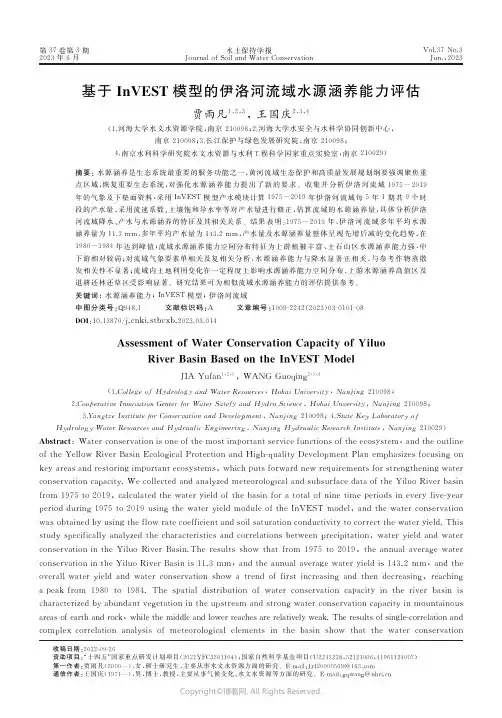
第37卷第3期2023年6月水土保持学报J o u r n a l o f S o i l a n d W a t e rC o n s e r v a t i o nV o l .37N o .3J u n .,2023收稿日期:2022-09-26资助项目: 十四五 国家重点研发计划项目(2021Y F C 3201104);国家自然科学基金项目(U 2243228,52121006,41961124007) 第一作者:贾雨凡(2000 ),女,硕士研究生,主要从事水文水资源方面的研究㊂E -m a i l :J y f 20000509@163.c o m 通信作者:王国庆(1971 ),男,博士,教授,主要从事气候变化㊁水文水资源等方面的研究㊂E -m a i l :g q w a n g@n h r i .c n 基于I n V E S T 模型的伊洛河流域水源涵养能力评估贾雨凡1,2,3,王国庆2,3,4(1.河海大学水文水资源学院,南京210098;2.河海大学水安全与水科学协同创新中心,南京210098;3.长江保护与绿色发展研究院,南京210098;4.南京水利科学研究院水文水资源与水利工程科学国家重点实验室,南京210029)摘要:水源涵养是生态系统最重要的服务功能之一,黄河流域生态保护和高质量发展规划纲要强调聚焦重点区域,恢复重要生态系统,对强化水源涵养能力提出了新的要求㊂收集并分析伊洛河流域1975-2019年的气象及下垫面资料,采用I n V E S T 模型产水模块计算1975-2019年伊洛河流域每5年1期共9个时段的产水量,采用流速系数㊁土壤饱和导水率等对产水量进行修正,估算流域的水源涵养量,具体分析伊洛河流域降水㊁产水与水源涵养的特征及其相关关系㊂结果表明:1975-2019年,伊洛河流域多年平均水源涵养量为11.3mm ,多年平均产水量为143.2mm ,产水量及水源涵养量整体呈现先增后减的变化趋势,在1980-1984年达到峰值;流域水源涵养能力空间分布特征为上游植被丰富㊁土石山区水源涵养能力强,中下游相对较弱;对流域气象要素单相关及复相关分析,水源涵养能力与降水显著正相关,与参考作物蒸散发相关性不显著;流域内土地利用变化在一定程度上影响水源涵养能力空间分布,上游水源涵养高值区及退耕还林还草区受影响显著㊂研究结果可为相似流域水源涵养能力的评估提供参考㊂关键词:水源涵养能力;I n V E S T 模型;伊洛河流域中图分类号:Q 948.1 文献标识码:A 文章编号:1009-2242(2023)03-0101-08D O I :10.13870/j.c n k i .s t b c x b .2023.03.014A s s e s s m e n t o fW a t e rC o n s e r v a t i o nC a p a c i t y ofY i l u o R i v e rB a s i nB a s e do n t h e I n V E S T M o d e lJ I A Y u f a n 1,2,3,WA N G G u o q i n g2,3,4(1.C o l l e g e o f H y d r o l o g y a n d W a t e rR e s o u r c e s ,H o h a iU n i v e r s i t y ,N a n j i n g 210098;2.C o o p e r a t i v e I n n o v a t i o nG e n t e r f o rW a t e rS a t e f y a n d H y d r oS c i e n c e ,H o h a iU n v e r s i t y ,N a n j i n g 210098;3.Y a n g t z e I n s t i t u t e f o rC o n s e r v a t i o na n dD e v e l o p m e n t ,N a n j i n g 210098;4.S t a t eK e y L a b o r a t o r y o fH y d r o l o g y -W a t e rR e s o u r c e s a n d H y d r a u l i cE n g i n e e r i n g ,N a n j i n g H y d r a u l i cR e s e a r c hI n s t i t u t e ,N a n j i n g 210029)A b s t r a c t :W a t e r c o n s e r v a t i o n i s o n e o f t h em o s t i m p o r t a n t s e r v i c e f u n c t i o n s o f t h e e c o s ys t e m ,a n d t h e o u t l i n e o f t h eY e l l o w R i v e rB a s i nE c o l o g i c a l P r o t e c t i o na n d H i g h -q u a l i t y D e v e l o p m e n tP l a ne m p h a s i z e s f o c u s i n g on k e y a r e a s a n d r e s t o r i n g i m p o r t a n t e c o s y s t e m s ,w h i c h p u t s f o r w a r d n e wr e q u i r e m e n t s f o r s t r e n g t h e n i n g w a t e r c o n s e r v a t i o n c a p a c i t y .W e c o l l e c t e d a n d a n a l y z e dm e t e o r o l o gi c a l a n d s u b s u r f a c e d a t a o f t h eY i l u oR i v e r b a s i n f r o m1975t o 2019,c a l c u l a t e d t h ew a t e r y i e l do f t h eb a s i n f o r a t o t a l o f n i n e t i m e p e r i o d s i ne v e r y f i v e -y e a r p e r i o dd u r i n g 1975t o2019u s i n g th ew a t e r y i e l dm o d u l eo f t h e I n V E S T m o d e l ,a n d t h ew a t e r c o n s e r v a t i o n w a s o b t a i n e d b y u s i n g t h e f l o wr a t e c o e f f i c i e n t a n d s o i l s a t u r a t i o n c o n d u c t i v i t y t o c o r r e c t t h ew a t e r yi e l d .T h i s s t u d y s p e c i f i c a l l y a n a l y z e dt h ec h a r a c t e r i s t i c sa n dc o r r e l a t i o n sb e t w e e n p r e c i p i t a t i o n ,w a t e r y i e l da n dw a t e r c o n s e r v a t i o n i n t h eY i l u oR i v e rB a s i n .T h er e s u l t ss h o wt h a t f r o m 1975t o2019,t h ea n n u a l a v e r a gew a t e r c o n s e r v a t i o n i n t h eY i l u oR i v e rB a s i n i s 11.3mm ,a n d t h e a n n u a l a v e r a g ew a t e r y i e l d i s 143.2mm ,a n d t h e o v e r a l lw a t e r y i e l da n d w a t e rc o n s e r v a t i o ns h o w at r e n do f f i r s t i n c r e a s i n g a n dt h e nd e c r e a s i n g ,r e a c h i n ga p e a kf r o m 1980t o1984.T h es p a t i a ld i s t r ib u t i o n o f w a t e rc o n s e r v a t i o nc a p a c i t y int h er i v e rb a s i ni s c h a r a c t e r i z e db y a b u n d a n t v e g e t a t i o n i n t h e u p s t r e a ma n d s t r o n g w a t e r c o n s e r v a t i o n c a p a c i t yi nm o u n t a i n o u s a r e a s o f e a r t h a n d r o c k ,w h i l e t h em i d d l e a n d l o w e r r e a c h e s a r e r e l a t i v e l y w e a k .T h e r e s u l t s o f s i n g l e -c o r r e l a t i o n a n d c o m p l e xc o r r e l a t i o n a n a l y s i so f m e t e o r o l o gi c a le l e m e n t si nt h e b a s i n s h o w t h a tt h e w a t e rc o n s e r v a t i o n Copyright ©博看网. All Rights Reserved.c a p a c i t y i s s i g n i f i c a n t l yp o s i t i v e l y c o r r e l a t e dw i t h p r e c i p i t a t i o n,b u t n o tw i t he v a p o t r a n s p i r a t i o no f r e f e r e n c e c r o p s.T o a c e r t a i ne x t e n t,t h e c h a n g eo f l a n du s e i n t h e r i v e rb a s i na f f e c t s t h e s p a t i a ld i s t r i b u t i o no fw a te r c o n s e r v a t i o n c a p a c i t y,a n d t h e a r e a sw i t hh i g hv a l u e o fw a t e r c o n s e r v a t i o n i n t h e u p p e r r e a c h e s a n d t h e a r e a s w h e r ef a r m l a n di sr e t u r n e dt of o r e s ta n dg r a s s l a n da r es i g n i f i c a n t l y a f f e c t e d.Th er e s u l t sc a n p r o vi d ea r e f e r e n c e f o r t h e a s s e s s m e n t o fw a t e r c o n s e r v a t i o n c a p a c i t y i n s i m i l a r r i v e r b a s i n s.K e y w o r d s:w a t e r c o n s e r v a t i o n c a p a c i t y;I n V E S T m o d e l;Y i l u oR i v e rB a s i n联合国政府间气候变化专门委员会(i n t e r g o v e r n-m e n t a l p a n e l o n c l i m a t e c h a n g e,I P C C)第六次评估报告[1]明确指出,2010 2019年全球平均气温较1850 1900年升高1.07ħ,气候变化已是毋庸置疑的事实[2]㊂工业革命以来,随着科学技术的发展,人类活动对于生态环境的影响日趋显著㊂如何应对人类活动和气候变化共同影响下的变化环境成为生态及水文等多学科多领域的研究重点㊂水源涵养作为水文生态交叉学科 生态水文学的研究范畴,是生态系统服务功能的重要内容之一㊂水源涵养功能是一个动态的㊁不断发展的概念[3-4],主流观点[5]认为,水源涵养功能是指生态系统在特定时间㊁特定条件下的保水能力,进一步可细分为狭义和广义2种定义㊂狭义的水源涵养功能通常指林地㊁草地等生态系统拦蓄降水㊁调节径流的功能;广义的水源涵养功能则考虑森林㊁草地㊁林地㊁沼泽㊁湖泊多种生态系统,以及水㊁土㊁气多种生态因子,涵盖拦蓄降水㊁调节径流㊁净化水质㊁水土保持㊁减少植被退化㊁改善下垫面条件㊁保护生物多样性㊁调节气候等多方面的生态环境保护功能㊂厘清水源涵养能力的概念和内涵㊁系统分析影响水源涵养能力的驱动因素㊁科学认识水源涵养能力评价方法的适应条件,不仅是环境科学㊁生态科学和水文科学交叉研究的核心内容,而且对生态恢复措施建设㊁区域水土保持和水资源合理调配具有相当重要的意义[6]㊂如何有效评估生态系统水源涵养能力是水源涵养功能研究的重点㊂主流的评估方法包括传统水文学方法和水文模型法2大类[7]㊂传统方法注重试验,结果相对准确,但多以点尺度为主,无法很好反映空间分布情况㊂典型的方法如林冠截留剩余量法[8]㊁降水储存法㊁年径流量法[9]等均存在类似缺陷㊂相对完善的是综合蓄水能力法,该法统筹考虑林冠层㊁枯落物层和土壤层,将3个层面的总拦蓄降水作为森林水源涵养量,全面分析森林生态系统的各个水文过程㊂但由于层次较多,实测资料需求复杂,实际操作存在困难[10]㊂与传统方法相对的水文模型法则在大尺度研究中具有显著优势,但计算准确度受计算资料的精度和长度控制,对资料的要求较高[11]㊂目前,国内外学者常用的水文模型包括美国农业部水土保持局开发的S C S模型[12]㊁生态系统服务和权衡的综合评估模型[13]㊁温度植被干旱指数模型[14]和S WA T模型[15]等,以斯坦福大学环境研究所㊁世界自然保护基金会等联合开发的I n V E S T模型在水源涵养评估领域应用最为广泛㊂通过收集到的气象站点数据及下垫面资料分析伊洛河流域降水的演变特征㊂在此基础上,采用I n V E S T 模型产水模块对伊洛河流域1975 2019年每5年1期的产水量进行计算㊂对计算得到的产水量数据,采用土壤饱和导水率㊁流速系数等进行修正,得到伊洛河流域9期平均水源涵养量并分析其时空分布特征,以期为流域水源涵养能力的评估与提升提供参考㊂1材料与方法1.1研究流域伊洛河流域发源于河南省栾川县(34ʎ49'30ᵡN, 111ʎ28'01ᵡE),是黄河三门峡以下最大的支流,同时也是河南省境内最大的黄河支流㊂河流分有伊河㊁洛河两支,全长447k m,总面积18881k m2㊂流域大部分隶属于华北山地丘陵区和华北平原区,上游为土石山区,植被丰富;下游多低山丘陵㊁河谷平原㊂伊洛河地处湿润半湿润区,是黄河流域重要的水源涵养区之一,属大陆性季风气候区,夏季炎热多雨,冬季寒冷多雪[16]㊂研究区域多年平均降水量为660mm,其中6 9月汛期降水占全年的60%㊂从空间分布上看,上游降水相对丰沛,下游偏少[17]㊂流域多年平均参考作物蒸散发为1100mm,东西部蒸散较中部偏少㊂研究区域地理位置及气候站点分布情况见图1㊂图1伊洛河流域地理位置及气象站点分布研究采用地理空间数据云提供的D E M(90mˑ90 m)数据和基于美国陆地卫星L a n d s a tT M影像的1k m 栅格数据,将流域的主要土地利用分为耕地㊁林地㊁草201水土保持学报第37卷Copyright©博看网. All Rights Reserved.地㊁水体㊁建设用地以及未利用地6种类型㊂收集整理研究区域及周边共11个气象站点逐日降水资料㊁最高和最低气温资料,采用改进H a r g r e a v e s公式计算参考作物蒸散发(E T0)[18]㊂土壤数据采用国家科技基础条件平台 国家地球系统科学数据中心 土壤分中心(h t t p://s o i l.g e o d a t a.c n)提供的资料[19]㊂植物可利用水量由周文佐[20]提出的土壤质地相关公式计算㊂1.2I n V E S T模型I n V E S T模型是由斯坦福大学环境研究所㊁世界自然保护基金会等联合开发的生态系统服务评估与权衡模型,模型产水模块基于B u d y k o水热耦合公式及水量平衡方程对区域各网格产水进行评估,其基本原理见图2㊂I n V E S T模型产水模块计算的基本公式为:Y x=(1-A E T x P x)㊃P x(1)式中:A E T x表示栅格单元x的实际蒸散发(mm); P x栅格单元x的年降水量(mm)㊂图2I n V E S T模型产水模块水量平衡示意产水水量平衡公式中土地利用为植被的实际蒸散由Z h a n g等[21]提出的B u d y k o水热耦合公式计算,公式为:A E T xP x=1+P E T xP x-[1+(P E T xP x)ωx]1ωx(2)式中:A E T x表示潜在蒸散发量(mm);ωx表示自然气候-土壤性质的非物理参数㊂其他土地利用/覆被类型(开放水域㊁城市㊁湿地)的实际蒸散发通过参考作物蒸散发直接计算,由降水量决定其最大值,计算公式为:A E T x=M i n(K c(l c)㊃E T0,P x)(3)式中:K c(l c)为特定土地利用类型对应的植被蒸散系数,通过生物物理系数表进行匹配㊂模型得到的产水还需利用地形指数等将其进行修正为水源涵养量[22],修正公式为:WR=M i n(249/V,1)ˑM i n(1,0.9ˑT I/3)ˑM i n(1,K/300)ˑY(4)式中:WR为研究区域水源涵养量(mm);T I为地形指数;V为流速系数;K为土壤饱和导水率(c m/ d a y);Y为模型计算的产水量(mm)㊂地形指数通过流域D E M计算得到,公式为:T I=l o g(D/SˑP)(5)式中:D为集水区栅格数量,无量纲;S为土层深度(mm);P为百分比坡度,由流域D E M计算得到㊂流速系数根据植被类型查阅参考文献[23]获得,水田㊁水体㊁建设用地取2012,林地㊁草地㊁岩石及裸地分别取200,500,1500㊂土壤饱和导水率采用C o s b y土壤传递公式计算[24],公式为:K s=1.148ˑ10(-0.6+1.26ˑ10-2c2-6.4ˑ10-3c1)(6)式中:K s为土壤饱和导水率(m/d);c1㊁c2分别为土壤的黏粒和砂粒含量(%)㊂研究区域土壤饱和导水率计算结果见图3㊂图3伊洛河流域土壤植被参数空间分布2结果与分析2.1伊洛河流域降水演变特征伊洛河流域多年平均降水量为669m m,由图4可知,1975 2019年流域年降水量及其5年滑动平均过程,年降水量呈现非显著性下降趋势,降水量最低值为443m m,出现于1997年;最大值为944m m,出现于1984年㊂从滑动平均过程来看,1983年前后明显偏高,达940 m m,此后,年降水量总体稳定在660m m左右㊂对研究区域各栅格单元的降水及参考作物蒸散发45年数据进行线性拟合,拟合斜率即为研究时段内流域降水及蒸散变率㊂由降水变率的空间分布情况(图5a)可知,年降水量呈现自西南向东北㊁自上游向下游递减的空间格局;从多年平均降水量的空间分布(图5b)来看,1975 2019年伊洛河降水量在流域下游表现出较显著的下降趋势,而在上游则有所增加,二者互相抵消,流域整体降水量变化不大㊂301第3期贾雨凡等:基于I n V E S T模型的伊洛河流域水源涵养能力评估Copyright©博看网. All Rights Reserved.图41975-2019年伊洛河流域年降水量变化过程降水是影响流域水源涵养能力的重要气象要素,由图6可知,1975 2019年伊洛河流域5年平均降水量的空间分布情况,伊洛河源头区2005年以前降水呈现明显的先增加后减少的趋势,此后稳定在675m m左右㊂其中,2000 2004年源头区降水显著减少,流域下游降水显著增加,呈现出与整体相反的趋势㊂对该特殊规律进行进一步分析发现,上游华山站在2001 2002年降水量均在600m m以下,明显低于该站多年平均值(783 m m)㊂相对应的是,中游孟津站在2003年降雨则罕见地达到1000m m以上㊂这一降水分布规律同时对该时段产水及水源涵养造成一定的影响㊂图5伊洛河流域多年平均降水量及年降水变率的空间分布图6伊洛河流域降水空间分布情况2.2伊洛河流域产水量时空变化以5年为1个时段,将1975 2019年划分为9个时段,采用伊洛河流域气象资料5年平均栅格数据及对应时段末年份的土地利用资料,输入I n V E S T 模型计算流域的5年平均产水量㊂由于缺少1979年的土地利用资料,1975 1979年土地利用资料采用1980年的资料替代㊂研究采用伊洛河流域控制站黑石关站多年平均天然径流数据对模型产水模块进行校准㊂图7和图8分别为伊洛河流域产水量的年代际变化过程和流域9个时段产水量的空间分布状况㊂由图7可知,伊洛河流域多期平均产水量为143.2 m m㊂其中,1980 1984年流域产水量最高,达222.1m m; 1995 1999年产水量最低,仅为107.3m m㊂流域整体产水量呈现先增后减的趋势,1985年及1980年降水量较高,对应的产水在1980 1984年达到峰值㊂同理可见, 1985 1994年连续的降水减少使产水在1990 1994年跌入低谷㊂从年际变化上看,产水和降水呈现高度一致,表明模型在产水模拟上准确性较高㊂由图8可知,流域产水量在1975 2019年间呈现相似的规律为上游降水丰沛的地区产水量高,中下游产水相对较少㊂源头区产水量呈现先减少后略增加的趋势㊂2000 2004年受华山站附近降水的减少及孟津降水剧烈增加的影响,源头区产水呈现明显的降低趋势,2005年以后降水恢复平均水平,源头区产水逐步回升㊂产水的9期空间分布规律基本与降水分布对应,进一步论证I n V E S T模型在该流域的适应性㊂401水土保持学报第37卷Copyright©博看网. All Rights Reserved.图7 伊洛河流域降水量及产水量过程2.3 伊洛河流域水源涵养量时空分布研究采用土壤饱和导水率㊁流速系数等对模型计算的产水量进行修正,进而估算各期水源涵养量㊂图9和图10分别为伊洛河流域水源涵养量年代际变化过程和9个时段水源涵养量的空间分布特征㊂伊洛河流域多年平均水源涵养量11.30m m ㊂其中,1980 1984年水源涵养量最大,达18.98m m ;1995 1999年水源涵养量最低,仅为8.26mm ㊂水源涵养量在45年间变化趋势与产水量基本一致,水源涵养量与产水量比值在8%左右,波动不大,且该比值与降水量的正相关关系㊂图8 伊洛河流域产水量空间分布图9 伊洛河流域水源涵养量及降水量年代际变化过程图10为伊洛河流域水源涵养量的空间分布情况,伊洛河水源涵养高值区出现在流域上游西北部,低值区广泛分布于流域中部和东北部地区,整体呈现自东向西增加趋势,这一趋势与降水空间变化基本一致㊂此外,流域内不同地区水源涵养量存在较大的差异㊂降水量大且蒸散相对较小的地区水源涵养能力显著高于其他地区㊂相反,从年际分布上看,流域水源涵养量整体下降,1975 1984年以后出现明显下降趋势㊂3 讨论为进一步分析水源涵养量时空分布变化的原因,研究对评估过程各要素进行具体分析㊂水源涵养能力的空间分布主要受气候条件和土地利用变化的影响㊂由图9可知,水源涵养量较高的时期降水量较大,随着降水减少和温度逐年上升,流域水源涵养量出现逐期下降的趋势㊂为量化体现降水对水源涵养量的影响程度,对二者进行单相关和偏相关分析,由图11可知,气象要素与水源涵养量的相关系数分布情况,降水量在流域绝大部分地区与水源涵养量存在显著的正相关关系㊂为分析人类活动影响下土地利用变化对流域水源涵养功能的影响过程,选取受人类活动影响前的土地利用资料(1980年)计算当前气象条件(20152019年)背景下的伊洛河流域水源涵养量(图12)㊂结果显示,流域整体水源涵养量变化不大,平均水源涵养量较变化前降低0.08mm ,仅占2020年水源涵养的0.15%㊂表1为1980-2019年间流域土地利用501第3期 贾雨凡等:基于I n V E S T 模型的伊洛河流域水源涵养能力评估Copyright ©博看网. All Rights Reserved.的变化情况,由表1可知,1980 2020年虽然耕地和林地草地总面积变化幅度不大,但相互转化面积较多㊂西部水源涵养高值区和退耕还林还草区水源涵养量变化相对剧烈,其余地区则变化较小㊂图10伊洛河流域水源涵养量空间分布注:a㊁b㊁c㊁d分别为降水量与水源涵养量单相关系数分布㊁参考作物蒸散发与水源涵养量单相关系数分布㊁降水量与水源涵养量偏相关系数分布㊁参考作物蒸散发与水源涵养量偏相关系数分布㊂图11气象要素相关分析图12水源涵养量变化量分布基于水文模型对区域水源涵养能力进行大时空尺度评估是生态系统服务功能中水源涵养研究的未来发展方向㊂其中,I n V E S T模型在湿润半湿润地区水源涵养能力评估具有良好的适应性,能够有效反映区域水源涵养的空间分布情况㊂不同学者采用I n-V E S T模型的水源涵养评估存在一定的差异,刘树锋等[26]在杨溪河流域的研究显示流域水源涵养在一定程度上高于流域产水;刘宥延等[27]在黄土高原评估的水源涵养则占产水的12%左右㊂本文计算的水源涵养量大约占产水的8%,该占比随降水波动轻微变化㊂水源涵养与产水的数量关系主要受产水修正公601水土保持学报第37卷Copyright©博看网. All Rights Reserved.式中参数取值的影响,修正公式中的流速系数与土壤饱和率和地形指数为主要控制指标㊂针对不同地区选取不同流速系数和地形指数可能对水源涵养评估结果产生较大的影响㊂表1伊洛河流域土地利用变化年份农田面积/k m2占比/%林地面积/k m2占比/%草地面积/k m2占比/%水体面积/k m2占比/%建设用地面积/k m2占比/%未利用地面积/k m2占比/%1980644434.94889848.25262114.213561.931230.6710.01 1990642034.75894048.38265814.393371.821200.6520.01 1995635834.36888248.00269714.583842.081820.9800 2000634934.31887347.95270614.623892.101861.0100 2005628933.99887547.97271214.664142.242131.1500 2010626633.91887248.02270014.614132.242241.2120.01 2015619233.46886547.91272414.724492.432731.4800 2020590831.91881647.62284615.375633.043802.05004结论为进一步分析水源涵养量时空分布变化的原因,研究对评估过程各要素进行具体分析,水源涵养能力的空间分布主要受气候条件和土地利用变化的影响㊂本文根据I n V E S T模型[25]输入数据对降水量㊁蒸散发和土地利用类型3种水源涵养能力影响因素进行分析㊂由降水与水源涵养逐期演变(图9)可见,水源涵养量较高时期降水量较大,随着降水减少和温度逐年上升,流域水源涵养量出现逐期下降趋势㊂温度升高在I n V E S T模型产水计算中主要体现为参考作物蒸散发的变化,为量化体现降水和参考作物蒸散发对水源涵养量的影响程度,对二者分别进行单相关和偏相关分析,由图11气象要素与水源涵养量的相关系数分布情况可知,降水量在流域绝大部分地区与水源涵养量存在显著正相关关系,参考作物蒸散发的影响相对较小㊂为分析人类活动影响下土地利用变化对流域水源涵养功能的影响过程,研究选取受人类活动影响前土地利用资料(1980年)计算当前气象条件(2015-2019年)背景下的伊洛河流域水源涵养量(图12)㊂结果显示,流域整体水源涵养量变化不大,平均水源涵养量较变化前降低0.08mm,仅占2020年水源涵养量的0.15%㊂由1980-2019年流域土地利用的变化情况(表1)可知,1980-2020年建设用地和水体增加显著,农田面积有所减少,林地草地总面积变化幅度不大,但二者和耕地间相互转化较多㊂由于伊洛河流域1980年至今各土地利用类型相互转换多,总量变化少,因此,研究模拟的水源涵养量空间分布变化大,总量下降不显著㊂与土地利用变化相对应的西部水源涵养高值区和退耕还林还草区水源涵养量变化剧烈,其余地区变化较小㊂参考文献:[1]I n n v a eS,V i s tG,T r o m m a l d M,e t a l.H e a l t h p o l i c y-m a k e r s'p e r c e p t i o n s o f t h e i r u s e o f e v i d e n c e:As y s t e m a t i c r e v i e w[J].J o u r n a l o fH e a l t hS e r v i c e sR e s e a r c ha n dP o l i c y,2002,7(4): 239-244.[2]赵晓涵,张方敏,卢琦,等.未来气候情景内蒙古蒸散和产水量的变化特征[J].水土保持学报,2022,36(4):151-159. [3]张佳楠,张建军,张海博,等.晋西黄土区典型林分水源涵养能力评价[J].北京林业大学学报,2019,41(8):105-114. [4]张彪,李文华,谢高地,等.森林生态系统的水源涵养功能及其计量方法[J].生态学杂志,2009,28(3):529-534.[5]周佳雯,高吉喜,高志球,等.森林生态系统水源涵养服务功能解析[J].生态学报,2018,38(5):1679-1686. [6] H u W M,L i G,G a oZH,e t a l.A s s e s s m e n t o f t h e i m-p a c to ft h e p o p l a re c o l o g i c a lr e t r e a t p r o j e c to n w a t e rc o n s e r v a t i o n i n t h eD o n g t i n g L a k ew e t l a n dr e g i o nu s i n gt h e I n V E S T m o d e l[J].S c i e n c eo ft h e T o t a lE n v i r o n-m e n t,2020,733:e139423.[7]宫渊波,麻泽龙,陈林武,等.嘉陵江上游低山暴雨区不同水土保持林结构模式水源涵养效益研究[J].水土保持学报,2004,18(3):28-32.[8]侯晓臣,孙伟,李建贵,等.森林生态系统水源涵养能力计量方法研究进展与展望[J].干旱区资源与环境, 2018,32(1):121-127.[9]李文华,何永涛,杨丽韫.森林对径流影响研究的回顾与展望[J].自然资源学报,2001,16(5):398-406. [10]王晓学,沈会涛,李叙勇,等.森林水源涵养功能的多尺度内涵㊁过程及计量方法[J].生态学报,2013,33(4):1019-1030.[11]贾雨凡,杨勤丽,胡非池,等.变化环境下的水源涵养能力评估研究进展[J].水利水运工程学报,2022(1):37-47.[12]聂忆黄.基于地表能量平衡与S C S模型的祁连山水源涵养能力研究[J].地学前缘,2010,17(3):269-275.[13] R e d h e a d JW,S t r a t f o r dC,S h a r p sK,e t a l.E m p i r i c a lv a l i d a t i o no f t h e I n V E S Tw a t e r y i e l d e c o s y s t e ms e r v i c e701第3期贾雨凡等:基于I n V E S T模型的伊洛河流域水源涵养能力评估Copyright©博看网. All Rights Reserved.m o d e l a t an a t i o n a l s c a l e[J].S c i e n c eo f t h eT o t a lE n v i-r o n m e n t,2016,569/570:1418-1426.[14] S a n d h o l t I,R a s m u s s e nK,A n d e r s e n J.As i m p l e i n t e r-p r e t a t i o no ft h es u r f a c et e m p e r a t u r e/v e g e t a t i o ni n d e xs p a c e f o r a s s e s s m e n t o f s u r f a c em o i s t u r e s t a t u s[J].R e-m o t eS e n s i n g o fE n v i r o n m e n t,2002,79(2):213-224.[15] A r n o l dJG,S r i n i v a s a nR,M u t t i a hRS,e t a l.L a r g ea r e a h y d r o l o g i c m o d e l i n g a n d a s s e s s m e n t;P a r t I,M o d e l d e v e l o p m e n t[J].J o u r n a l o f t h eA m e r i c a n W a t e rR e s o u r c e sA s s o c i a t i o n,1998,34(1):73-89. [16]郭屹立,卢训令,丁圣彦.伊洛河河岸带生态系统草本植物功能群划分[J].生态学报,2012,32(14):4434-4442. [17]贺瑞敏,王国庆,张建云.环境变化对黄河中游伊洛河流域径流量的影响[J].水土保持研究,2007,14(2):297-298.[18]胡庆芳,杨大文,王银堂,等.H a r g r e a v e s公式的全局校正及适用性评价[J].水科学进展,2011,22(2):160-167. [19]国家地球系统科学数据中心.国家科技基础条件平台[R/O L].(2022-12-02)h t t p://w w w.g e o d a t a.c n. [20]周文佐.基于G I S的我国主要土壤类型土壤有效含水量研究[D].南京:南京农业大学,2003. [21] Z h a n g L,H i c k e lK,D a w e s W R,e ta l.A r a t i o n a lf u n c t i o na p p r o a c hf o re s t i m a t i ng m e a na n n u a le v a p o-t r a n s p i r a t i o n[J].W a t e rR e s o u r c e s R e s e a r c h,2004,40(2):1-14.[22]余新晓,周彬,吕锡芝,等.基于I n V E S T模型的北京山区森林水源涵养功能评估[J].林业科学,2012,48(10):1-5.[23] A l l e nR G.C r o p e v a p o t r a n s p i r a t i o n-G u i d e l i n e s f o r c o m p u-t i n g c r o p w a t e r r e q u i r e m e n t s-F A OI r r i g a t i o n a n dd r a i n-a g e p a p e r56[M].R o m e:F A O-F o o da n d A g r i c u l t u r eO r g a n i z a t i o no f t h eU n i t e dN a t i o n s,1998. [24] C o s b y BJ,H o r n b e r g e rG M,C l a p p RB,e t a l.As t a-t i s t i c a l e x p l o r a t i o no f t h e r e l a t i o n s h i p s o f s o i lm o i s t u r ec h a r a c t e r i s t i c s t ot h e p h y s i c a l p r o p e r t i e so fs o i l s[J].W a t e rR e s o u r c e sR e s e a r c h,1984,20(6):682-690. [25]顾铮鸣,金晓斌,沈春竹,等.近15年江苏省水源涵养功能时空变化与影响因素探析[J].长江流域资源与环境,2018,27(11):2453-2462.[26]刘树锋,陈记臣,关帅,等.基于I n V E S T模型的未来土地利用变化对水源涵养功能的影响:以杨溪河流域为例[J].安徽农业科学,2020,48(15):67-70. [27]刘宥延,刘兴元,张博,等.基于I n V E S T模型的黄土高原丘陵区水源涵养功能空间特征分析[J].生态学报,2020,40(17):6161-6170.(上接第100页)[22]高君亮,高永,吴波,等.戈壁地表土壤颗粒的空间变异特征研究[J].土壤,2019,51(1):135-141. [23]曹媛,孟明,王磊,等.宁夏中部干旱带天然草地土壤颗粒空间分布特征[J].中国水土保持,2021(2):56-59.[24]杨振奇,秦富仓,李旻宇,等.砒砂岩区不同土地利用类型土壤入渗性能及其影响因素研究[J].生态环境学报,2020,29(4):733-739.[25]杨振奇,秦富仓,李龙,等.砒砂岩区小流域土壤有机质空间分布特征及其影响因素[J].农业工程学报,2019,35(17):154-161.[26]王晨沣.不同近地表土壤水文条件下黄壤坡面细沟间侵蚀过程机理[D].北京:北京林业大学,2019. [27]张合兵,聂小军,程静霞.137C s示踪采煤沉陷坡土壤侵蚀及其对土壤养分的影响[J].农业工程学报,2015,31(4):137-143.[28]高光耀,傅伯杰,吕一河,等.干旱半干旱区坡面覆被格局的水土流失效应研究进展[J].生态学报,2013,33(1):12-22.[29]于国强,李占斌,李鹏,等.不同植被类型的坡面径流侵蚀产沙试验研究[J].水科学进展,2010,21(5):593-599. [30]余新晓,张晓明,武思宏,等.黄土区林草植被与降水对坡面径流和侵蚀产沙的影响[J].山地学报,2006(1):19-26.[31]王冬冬,高磊,陈效民,等.红壤丘陵区坡地土壤颗粒组成的空间分布特征研究[J].土壤,2016,48(2):361-367. [32]钱秋颖,秦富仓,李龙,等.自然降雨条件下坡面侵蚀地表粗糙度的空间异质性[J].水土保持学报,2021,35(3):46-52.[33]石建省,叶浩,王强恒,等.水岩作用对内蒙古南部砒砂岩风化侵蚀的影响分析[J].现代地质,2009,23(1):171-177.801水土保持学报第37卷Copyright©博看网. All Rights Reserved.。
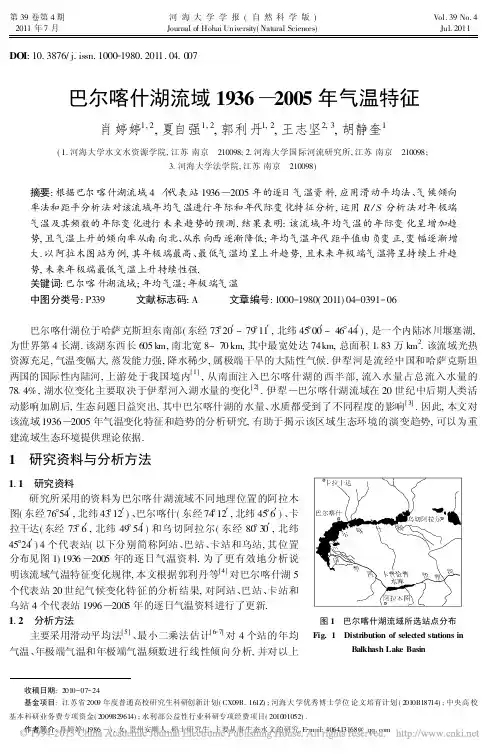
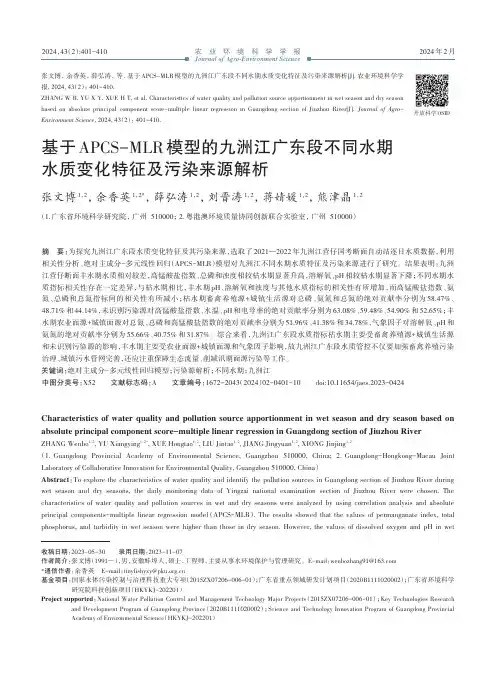
张文博,余香英,薛弘涛,等.基于APCS-MLR 模型的九洲江广东段不同水期水质变化特征及污染来源解析[J].农业环境科学学报,2024,43(2):401-410.ZHANG W B,YU X Y,XUE H T,et al.Characteristics of water quality and pollution source apportionment in wet season and dry season based on absolute principal component score-multiple linear regression in Guangdong section of Jiuzhou River[J].Journal of Agro-Environment Science ,2024,43(2):401-410.基于APCS-MLR 模型的九洲江广东段不同水期水质变化特征及污染来源解析张文博1,2,余香英1,2*,薛弘涛1,2,刘晋涛1,2,蒋婧媛1,2,熊津晶1,2(1.广东省环境科学研究院,广州510000;2.粤港澳环境质量协同创新联合实验室,广州510000)Characteristics of water quality and pollution source apportionment in wet season and dry season based onabsolute principal component score-multiple linear regression in Guangdong section of Jiuzhou RiverZHANG Wenbo 1,2,YU Xiangying 1,2*,XUE Hongtao 1,2,LIU Jintao 1,2,JIANG Jingyuan 1,2,XIONG Jinjing 1,2(1.Guangdong Provincial Academy of Environmental Science,Guangzhou 510000,China; 2.Guangdong-Hongkong-Macau Joint Laboratory of Collaborative Innovation for Environmental Quality,Guangzhou 510000,China )Abstract :To explore the characteristics of water quality and identify the pollution sources in Guangdong section of Jiuzhou River during wet season and dry seasons,the daily monitoring data of Yingzai national examination section of Jiuzhou River were chosen.The characteristics of water quality and pollution sources in wet and dry seasons were analyzed by using correlation analysis and absoluteprincipal components-multiple linear regression model (APCS-MLR ).The results showed that the values of permanganate index,total phosphorus,and turbidity in wet season were higher than those in dry season.However,the values of dissolved oxygen and pH in wet收稿日期:2023-05-30录用日期:2023-11-07作者简介:张文博(1991—),男,安徽蚌埠人,硕士,工程师,主要从事水环境保护与管理研究。
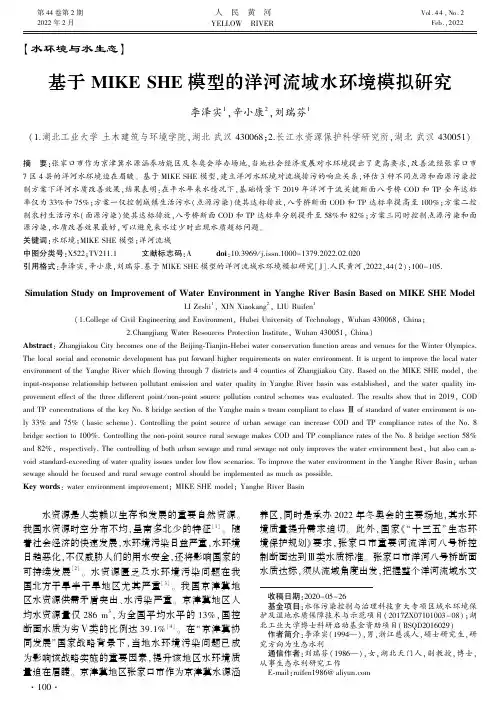
收稿日期:2020-05-26 基金项目:水体污染控制与治理科技重大专项区域水环境保
护及湿地水质保障技术与示范项目(2017ZX07101003-08);湖北工业大学博士科研启动基金资助项目(BSQD2016029) 作者简介:李泽实(1994—),男,浙江慈溪人,硕士研究生,研
究方向为生态水利 通信作者:刘瑞芬(1986—),女,湖北天门人,副教授,博士,
从事生态水利研究工作 E⁃mail:ruifen1986@aliyun.com
【水环境与水生态】基于MIKESHE模型的洋河流域水环境模拟研究李泽实1,辛小康2,刘瑞芬1(1.湖北工业大学土木建筑与环境学院,湖北武汉430068;2.长江水资源保护科学研究所,湖北武汉430051)摘 要:张家口市作为京津冀水源涵养功能区及冬奥会举办场地,当地社会经济发展对水环境提出了更高要求,改善流经张家口市7区4县的洋河水环境迫在眉睫。基于MIKESHE模型,建立洋河水环境对流域排污的响应关系,评估3种不同点源和面源污染控
制方案下洋河水质改善效果,结果表明:在平水年来水情况下,基础情景下2019年洋河干流关键断面八号桥COD和TP全年达标率仅为33%和75%;方案一仅控制城镇生活污水(点源污染)使其达标排放,八号桥断面COD和TP达标率提高至100%;方案二控制农村生活污水(面源污染)使其达标排放,八号桥断面COD和TP达标率分别提升至58%和82%;方案三同时控制点源污染和面源污染,水质改善效果最好,可以避免来水过少时出现水质超标问题。关键词:水环境;MIKESHE模型;洋河流域中图分类号:X522;TV211.1 文献标志码:A doi:10.3969/j.issn.1000-1379.2022.02.020 引用格式:李泽实,辛小康,刘瑞芬.基于MIKESHE模型的洋河流域水环境模拟研究[J].人民黄河,2022,44(2):100-105.
SimulationStudyonImprovementofWaterEnvironmentinYangheRiverBasinBasedonMIKESHEModelLIZeshi1,XINXiaokang2,LIURuifen1
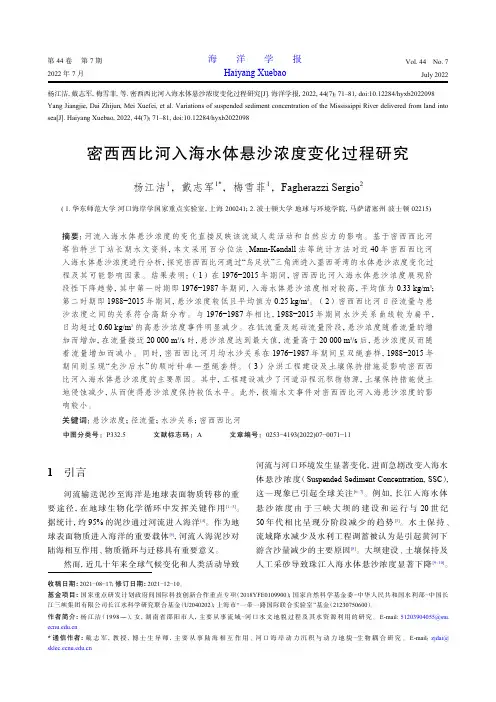
杨江洁,戴志军,梅雪菲,等. 密西西比河入海水体悬沙浓度变化过程研究[J]. 海洋学报,2022,44(7):71–81,doi:10.12284/hyxb2022098Yang Jiangjie,Dai Zhijun,Mei Xuefei, et al. Variations of suspended sediment concentration of the Mississippi River delivered from land intosea[J]. Haiyang Xuebao,2022, 44(7):71–81,doi:10.12284/hyxb2022098
密西西比河入海水体悬沙浓度变化过程研究
杨江洁1,戴志军1*,梅雪菲1,Fagherazzi Sergio2( 1. 华东师范大学 河口海岸学国家重点实验室,上海 200241;2. 波士顿大学 地球与环境学院,马萨诸塞州 波士顿 02215)摘要:河流入海水体悬沙浓度的变化直接反映该流域人类活动和自然应力的影响。基于密西西比河塔伯特兰丁站长期水文资料,本文采用百分位法、Mann-Kendall法等统计方法对近40年密西西比河入海水体悬沙浓度进行分析,探究密西西比河通过“鸟足状”三角洲进入墨西哥湾的水体悬沙浓度变化过程及其可能影响因素。结果表明:(1)在1976−2015年期间,密西西比河入海水体悬沙浓度展现阶段性下降趋势,其中第一时期即1976−1987年期间,入海水体悬沙浓度相对较高,平均值为0.33 kg/m3;第二时期即1988−2015年期间,悬沙浓度较低且平均值为0.25 kg/m3。(2)密西西比河日径流量与悬沙浓度之间的关系符合高斯分布。与1976−1987年相比,1988−2015年期间水沙关系曲线较为扁平,日均超过0.60 kg/m3的高悬沙浓度事件明显减少。在低流量及起动流量阶段,悬沙浓度随着流量的增加而增加,在流量接近20 000 m3/s时,悬沙浓度达到最大值,流量高于20 000 m3/s后,悬沙浓度反而随
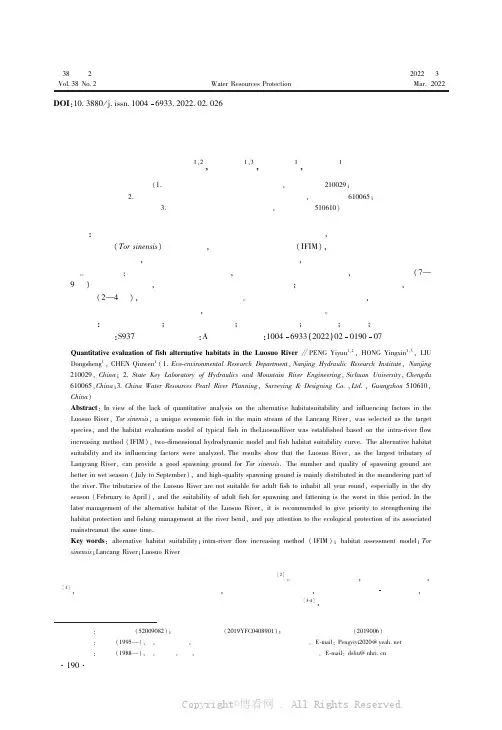
第38卷第2期Vol.38No.2水㊀资㊀源㊀保㊀护Water Resources Protection2022年3月Mar.2022㊀㊀基金项目:国家自然基金(52009082);国家重点研发计划(2019YFC0408901);江苏省水利重点科技项目(2019006)作者简介:彭依云(1995 ),女,博士研究生,主要从事梯级水库鱼类栖息地与生境研究㊂E-mail:Pengyiyi2020@ 通信作者:刘东升(1988 ),男,工程师,博士,主要从事河湖关键带水文地球化学过程研究㊂E-mail:dsliu@DOI :10.3880/j.issn.10046933.2022.02.026罗梭江鱼类替代生境量化评价彭依云1,2,洪迎新1,3,刘东升1,陈求稳1(1.南京水利科学研究院生态环境研究所,江苏南京㊀210029;2.四川大学水力学与山区河流开发保护国家重点实验室,四川成都㊀610065;3.中水珠江规划勘测设计有限公司,广东广州㊀510610)摘要:针对罗梭江替代生境适宜度及影响因素尚缺乏定量分析的问题,选取澜沧江干流特有经济鱼类中国结鱼(Tor sinensis )为目标物种,基于河流内流量增加法(IFIM ),结合二维水动力模型和鱼类栖息地适宜性曲线,建立了罗梭江典型鱼类的栖息地评价模型,分析了替代生境适宜度及其影响因子㊂结果表明:罗梭江作为澜沧江最大支流,能为中国结鱼提供良好产卵场,产卵场在丰水期(79月)数量和质量较优,高质量产卵场主要分布于河流蜿蜒处;罗梭江不适宜成鱼全年栖息,尤其在枯水期(2 4月),成鱼产卵及育肥适宜度最差㊂在罗梭江替代生境后期管理中,建议优先加强对河流弯道处的生境保护及捕捞管理,同时重视其关联干流的生态保护㊂关键词:替代生境适宜度;河流内流量增加法;栖息地评价模型;中国结鱼;澜沧江;罗梭江中图分类号:S937㊀㊀文献标志码:A㊀㊀文章编号:10046933(2022)02019007Quantitative evaluation of fish alternative habitats in the Luosuo River ʊPENG Yiyun 1,2,HONG Yingxin 1,3,LIU Dongsheng 1,CHEN Qiuwen 1(1.Eco-environmental Research Department ,Nanjing Hydraulic Research Institute ,Nanjing 210029,China ;2.State Key Laboratory of Hydraulics and Mountain River Engineering ,Sichuan University ,Chengdu 610065,China ;3.China Water Resources Pearl River Planning ,Surveying &Designing Co.,Ltd.,Guangzhou 510610,China )Abstract :In view of the lack of quantitative analysis on the alternative habitatsuitability and influencing factors in the Luosuo River,Tor sinensis ,a unique economic fish in the main stream of the Lancang River,was selected as the target species,and the habitat evaluation model of typical fish in theLuosuoRiver was established based on the intra-river flow increasing method (IFIM),two-dimensional hydrodynamic model and fish habitat suitability curve.The alternative habitat suitability and its influencing factors were analyzed.The results show that the Luosuo River,as the largest tributary of Langcang River,can provide a good spawning ground for Tor sinensis .The number and quality of spawning ground are better in wet season (July to September),and high-quality spawning ground is mainly distributed in the meandering part of the river.The tributaries of the Luosuo River are not suitable for adult fish to inhabit all year round,especially in the dry season (February to April),and the suitability of adult fish for spawning and fattening is the worst in this period.In the later management of the alternative habitat of the Luosuo River,it is recommended to give priority to strengthening the habitat protection and fishing management at the river bend,and pay attention to the ecological protection of its associated mainstreamat the same time.Key words :alternative habitat suitability;intra-river flow increasing method (IFIM );habitat assessment model;Tor sinensis ;Lancang River;Luosuo River㊀㊀梯级水电开发是利用水能资源的一个重要模式[1],在水能丰富地区合理地建设梯级大坝,会将河流生态系统分割成多个具有相似生境的水库生态系统[2]㊂河流受大坝阻隔,连续性遭到破坏,河流形态发生转变,由河相转为河相湖相交替,甚至出现湖相形式[3-4],大量鱼类洄游的行为也会受到大坝阻挡,排卵繁育受到影响,从而导致鱼类的物种多样性和数量显著减少[5-6]㊂此外,梯级水库的建成将改变径流的季节性调节㊁泥沙截留㊁水文条件以及水温时空分布,也将破坏原有河流鱼类的自然栖息环境,并影响鱼类个体行为特性及种群间的基因交流,导致遗传多样性的丧失[7]㊂为了减轻梯级水电开发对重要鱼类的不利影响,中国在水电开发和生态保护实践中逐渐形成了 干流开发,支流保护 的新思路[8],以支流生境条件补偿性保护干流中生境受水电开发破坏的鱼类,使流域水电开发和生态环境保护共同发展㊂栖息地模型是支流生境替代可行性分析和效果评价的常用方法,通过模拟目标生物在各生命时期行为对环境因子的响应关系以判断生境适宜性,对于栖息地评价较为全面和客观[9]㊂国内外针对鱼类栖息地模拟的研究已有不少成果,如赵尚飞等[10]使用River2D水生生物栖息地模型模拟了不同类型河道鱼类栖息地差㊁中㊁良3个等级的分布及变化;孙志毅[11]将MIKE11模型和PHABSIM模型进行耦合,建立了模拟交汇河流对特有鱼类生境影响的河流生态水力学模型;Ceola等[12]将三维水动力模型(estuary lake and coastal ocean model,ELCOM)和水生生态系统动态模型(computational aquatic ecosystem dynamics model,CAEDYM)进行耦合,并对红点鲑鱼在不同水文条件的栖息地下的变化情况进行了模拟预测;唐磊[13]通过建立一维生态河貌模型,结合目标鱼类的生境特征,定量评价了水坝拆除对支流替代生境的改善效果㊂尽管如此,目前鲜有模型应用于支流生境替代效果的分析,以至于缺乏替代生境适宜度及其影响因素的定量评价㊂已有研究表明,罗梭江作为澜沧江最大的支流,对干流受水电开发影响严重的鱼类起到了很好的替代保护作用[14-16]㊂其干支流水温差异㊁关键涨水过程以及河流联通性3个要素评价都达到最佳状态,重要鱼类保护程度㊁水污染状况㊁生态基流㊁生境多样性以及鱼类 三场 分布等要素评价结果良好㊂因此,本研究选择罗梭江作为研究对象,基于河流内流量增加法(intra-river flow increasing method, IFIM),结合EFDC(environmental fluid dynamics code)二维水动力模型和鱼类栖息地适宜性曲线,建立澜沧江典型鱼类中国结鱼的栖息地评价模型,通过计算目标鱼类栖息地适宜性指数(habitat suitability index,HSI)以及有效利用面积(weighted usable area,WUA)等关键因子,对罗梭江鱼类栖息地的数量和质量展开分析与探讨,评价不同水情下替代生境对目标鱼类的适宜度,对其生境替代效果进行量化评价,以期为罗梭江替代生境后期管理提供参考㊂1㊀研究区概况澜沧江湄公河发源于青藏高原唐古拉山北麓的小冰川,全长4880km,流域面积8320km2,是河长世界排名第6㊁流域面积世界排名第14的大河㊂罗梭江发源于普洱市宁洱县,是澜沧江湄公河的最大支流,主要河道长297.8km,流域面积7678.9km2[17-18],多年平均流量169.5m3/s㊂澜沧江湄公河生境发生变化后,罗梭江的流水生境成为喜流水性鱼类(如中国结鱼)的不二选择㊂2007年成立罗梭江州级鱼类保护区,主要保护对象包括叉尾鲇(Wallago attu)㊁丝尾鳠(Hemibagrus wyckioides)㊁中华鲱鲇(Clupisoma sinense)㊁中国结鱼(Tor sinensis)等[19-20]㊂其中,保护区核心段为磨者河和罗梭江汇合的河口与罗梭江和澜沧江汇合河口之间的河段,主要受保护鱼类为中国结鱼㊁丝尾鳠等㊂本文模拟江段选取罗梭江磨者河汇口至南醒河汇口,占罗梭江鱼类自然保护区核心区域的73%,全长29.2km,落差33m,平均比降1.13ɢ㊂模型上边界为磨者河汇口下游100m,下边界为南醒河汇口上游100m(图1)㊂图1㊀研究区水系及研究河段Fig.1㊀Water system and river reach in study area2㊀研究方法2.1㊀水动力模型采用EFDC模型对罗梭江进行水动力模拟研究,该模型可用于模拟地表水系统中的三维流场[21]㊁生物化学过程以及物质传输[22],研发较为成熟,目前被国内外广泛应用㊂考虑到模拟分辨率及计算效率,本研究采用正交曲线网格划分区域,沿流向划分500个网格,纵向平均长度为59.7m;由于河道较长,为确保网格质量,在河流宽度方向划分8个网格,平均宽度9.8m,共计4000个网格(图2)㊂为确保模拟的准确性,网格应适应模拟区域并保持正交性,计算网格的平均正交偏差应小于3.0ʎ㊂本次模拟计算的平均正交偏差为2.98ʎ,整体精度满足要求㊂图2㊀计算区域网格划分Fig.2㊀Grid division of caculation areaEFDC 模型使用的地形数据来自文献调研,其中曼安水文站以下河道河底高程来自Wang 等[19]2012年12月的实测数据,以上河段依据河床平均坡度及周围高程对断面进行手动插值,共获得43个断面高程数据㊂根据断面数据,再由EFDC 内置程序对研究区域全河段进行网格平均插值,插值计算完成后,对局部高程变化较大的区域进行了光滑处理㊂考虑到模型上边界至水文站及以下河段没有大型支流汇入,忽略一些小沟渠汇入的水量,将整个模型中的水量视为统一值,上边界输入流量为曼安水文站实测流量,下边界水位利用MIKE11构建一维模型进行推算㊂将曼安水文站1959 2008年的多年月平均径流量作为研究区的代表流量用于模型计算,时间步长设置为静态时间步长,取值1d㊂模型运行前,首先对降水量㊁气温㊁蒸发量等基本参数进行确定;曼宁系数可直观反映河道的粗糙度,与河流形态㊁河床结构底质等密切相关,本文参考‘天然河流糙率表“,取值为0.035㊂采用水位对EFDC 模型模拟结果进行率定验证㊂实测水位于2019年3月测得,为模拟河道沿水流方向的8个点位数据(图1),该模型使用3月多年月平均流量(33.95576m 3/s)进行模拟,S1~S4为率定点位,S5~S8为验证点位㊂率定点位的平均误差为0.035m,最大误差为0.04m;验证点位的平均误差为0.063m,最大误差为0.14m,结果表明EFDC 模型具有较高的可靠性和精准性㊂曼安水文站1959 2008年实际年径流量过程表明,径流量年际变化幅度不大,年际极值比较低;年径流累积量过程线也表明年径流没有很大波动,这说明EFDC 模型计算选用曼安水文站多年月平均径流作为研究区代表流量是可行的㊂为了满足EFDC 模型的计算要求,对于诸如边界㊁弯道等局部河段的网格的正交偏差也设置小于3.0ʎ㊂模型使用的河底高程数据来自文献调研,存在数据陈旧问题㊂然而,河底高程虽略有起伏,局部发生变化,但对于整个模拟河段来说,对河道的整体流场的影响较小㊂另外,根据本文模拟结果,高质量产卵场主要分布于河道蜿蜒处,说明栖息地适宜性主要受河道形态影响,而河道形态采用的是最新地形数据㊂从时间尺度上看,在河道形态及高程一致的情况下,影响流场的主要因素为不同月份所对应的流量与水位,即模型的边界条件㊂因此,河底高程数据的陈旧虽然会影响模型精度,但对本文整体规律和主要结论的影响是有限的㊂本文模型对水位的率定与验证平均误差均较小,证明了模型具有较高的可靠性与精准性㊂2.2㊀鱼类生境评价模型中国结鱼为澜沧江特有经济鱼类,栖于河道水流较缓处,为中下层鱼类,具有短距离洄游习性㊂幼鱼主要以摄取浮游动物为生,成鱼逐渐变为杂食性(植物的果实㊁鱼㊁甲壳动物与其他的无脊椎动物)㊂产卵期主要集中在7 9月,产卵时亲鱼上溯,选择卵石下的急流中繁殖[23]㊂本研究选取中国结鱼(图3)作为目标鱼类,评价生境适宜度,主要选择依据为:①鲤行目鱼类是澜沧江干支流的主要鱼类品种,且大部分喜急流环境㊁产沉性卵,中国结鱼作为其中最典型的一种,能很大程度上代表干支流鱼类的生活习性;②中国结鱼作为经济型鱼类,可围绕高效生态㊁优质安全的总体目标,推进罗梭江生态经济型渔业产业的可持续健康发展;③前人的研究表明,中国结鱼相关研究受到了较多关注,对于适宜环境因子的定量及生物学研究目前已经有不少研究成果[20,24]㊂相比较于其他种类的水生生物,鱼类在自身需要的生长环境中,倾向于选择有利于生长的空间和生境环境,避开不利条件[25]㊂所以可以通过分析河流生境特征来研究适于鱼类生活的区域特征参数,如水深㊁流速等[26]㊂在合适的水深条件中,鱼类能够更好地生存㊁栖息以及庇护自己,当水深过大时,容易影响沉性鱼卵及幼鱼的发育[27];流速综合反映了水流与河道坡度㊁河床糙率㊁河道宽度相互作用,一定流速条件下可以促进鱼类性腺生长发育,从而诱导其排卵[28]㊂综上所述,在保护鱼类栖息地方面,获取目标鱼类栖息地适宜性曲线非常重要,是建立栖息地模型的关键一环㊂本研究通过文献调研获取了中国结鱼流速㊁水深栖息地适宜性曲线[19],如图4所示㊂(a)活体(b)成鱼(663.1g)(c)幼鱼(27.7g)图3㊀中国结鱼Fig.3㊀Tor sinensis本研究基于IFIM法,结合EFDC二维水动力模型和鱼类栖息地适宜性曲线,建立了罗梭江典型鱼类中国结鱼的栖息地评价模型㊂IFIM法诞生于1970年代美国鱼类和野生动物保护中心[29],该方法通过将水力学模型和生物物理信息模型耦合,建立水动力因子与水生生物栖息地之间的偏好关系,为管理河流生态系统的健康提供依据[30]㊂IFIM法通过WUA和HSI[31]定量计算生物的有效生境的数量和质量,最后结合鱼类生活史对鱼类替代生境的可行性做出评价㊂为了表征支流生境对鱼类完整生活史的替代保护效果,本研究选取中国结鱼产卵和成鱼栖息两个阶段的适宜性进行评估㊂A WUA=ðn i=1I HS i A i(1)其中I HS i=V i D i C i式中:A WUA为WUA值;n为计算单元数;A i为计算单元i的面积;I HS i为计算单元i的HSI值;V i为计算单元i的适宜性流速;D i为计算单元i的适宜性水深;C i为计算单元i的河道适宜性指数(包括底质和覆盖物状况),本研究由于缺乏底质数据,暂不考虑河道指数,这里C i取值为1㊂(a)产卵流速(b)成鱼栖息流速(c)产卵水深(d)成鱼栖息水深图4㊀中国结鱼流速、水深栖息地适宜性曲线Fig.4㊀Habitat suitability curve of velocity andwater depth of Tor sinensis3㊀结果与分析3.1㊀替代生境质量评价由表1可见1959 2008年WUA均值年内变化情况,可见,产卵WUA值与成鱼WUA值年内变化趋势相同,均在8月达到峰值,分别为201.5万m2㊁211.9万m2;在4月达到最小值,分别为33.8万m 2㊁38.2万m 2㊂通过表1可算出,产卵和成鱼WUA 值变化趋势与流量表现出极显著正相关,相关系数分别为0.966㊁0.979(P <0.01)㊂7 10月产卵WUA 占河流面积超过50%,囊括了中国结鱼整个产卵期,同时,成鱼WUA 占比超过50%的时间也为7 10月,可见在一年中的绝大部分时间成鱼WUA 占河流面积比例均处于较低水平,在24月甚至低于20%(表1)㊂表1㊀栖息地总量计算结果Table 1㊀Calculation results of total habitats月份流量/(m 3㊃s -1)产卵WUA /万m 2产卵WUA 与河流面积比值成鱼WUA /万m 2成鱼WUA 与河流面积比值160.2661.60.2656.20.24244.0246.20.2045.70.19333.9636.40.1539.60.17431.3933.80.1438.20.16545.9748.10.2046.90.206116.41106.20.4591.50.397318.04182.50.77204.00.868426.71201.50.85211.90.899286.37174.90.74193.90.8210185.05141.80.60135.40.5711128.13113.50.4898.90.421281.18800.20.3469.60.29表2㊀鱼类栖息地适宜性指数赋分等级Table 2㊀Classification of fish habitat suitability index适宜性指数适宜性等级含义(0.7,1]适宜大部分水域的流速和水深条件,能为鱼类提供适宜的栖息生境(0.4,0.7]中等适宜大部分水域的流速和水深等条件,能为鱼类提供较适宜的栖息生境;或者有较多水域的流速和水深等条件,能为鱼类提供非常适宜或适宜的栖息生境(0.1,0.4]基本适宜大部分水域的流速和水深等条件,能为鱼类提供基本适宜的栖息生境;或者有较多水域的流速和水深等条件,能为鱼类提供基本适宜的栖息生境;或者有一定水域的流速和水深等条件,能为鱼类提供非常适宜或适宜的栖息生境(0,0.1]不适宜部分水域的域的流速和水深等条件差,不能为鱼类提供相对适宜的栖息生境3.2㊀替代生境适宜度时空变化特征参考Ding 等[32]所制定的栖息地适宜性标准,将栖息地质量分为不适宜㊁基本适宜㊁中等适宜及适宜4类(表2)㊂图5(a)为中国结鱼各月产卵栖息地质量等级占比情况,可见罗梭江中国结鱼产卵的适宜等级栖息地集中出现在6 11月,其中7 9月占河流面积比例较大,分别为65%㊁78%㊁60%,其他时间基本适宜栖息地占主导地位㊂图5(b)为中国结鱼各月成鱼栖息地质量等级占比情况,可见成鱼的适宜等级栖息地虽然全年均有出现,但占比较大者同样出现在7 9月,分别为82%㊁85%㊁75%,其余月份皆低于40%,而2 5月仅为10%左右㊂值得注意的是,不同于产卵栖息地占河流面积百分比总和在各月均达到100%,成鱼栖息地面积在大多数月份低于河流面积,即由于形成湖相区或者进入枯水季节,导致出现了HSI 值为0的区域,如2 5月各质量类型比值总和分别为56%㊁44%㊁41%㊁59%㊂(a)产卵(b)成鱼图5㊀中国结鱼各月产卵和成鱼栖息地质量等级占比Fig.5㊀Proportion of habitat quality grades of spawningand adult Tor sinensis in each month鉴于中国结鱼集中于7 9月有产卵栖息地需求,而成鱼栖息的替代生境适宜度由质量最差的时间段决定,因为此时鱼类将被迫离开该栖息地㊂因此,分别选取了7 9月产卵栖息地分布和2 4月成鱼栖息地分布(图6),进一步对鱼类栖息地的适宜度进行分析㊂由图6可见,8月研究河段处于适宜等级的面积占比最大,该月WUA 也处于最高水平;7月和9月相对8月适宜等级占比略小,WUA 也略低㊂总体而言,7 9月为集中产卵期,研究区域河段均表现出生境较为适宜,适宜等级产卵栖息地主要集中于河道蜿蜒处㊂成鱼栖息地在2 4月表现出极差的适宜性,不适宜等级占比最大,WUA 也相对较低㊂(a)7月产卵栖息地㊀㊀(b)8月产卵栖息地㊀㊀(c)9月产卵栖息地(d)2月成鱼栖息地㊀㊀(e)3月成鱼栖息地㊀㊀(f)4月成鱼栖息地图6㊀中国结鱼栖息地空间分布Fig.6㊀Spatial distribution of Tor sinensis habitat纵观各月栖息地情况,产卵栖息地和成鱼栖息地WUA 与各月流量大小紧密相关,当流量增大时,WUA 值也随之增加,相对应WUA 在研究河流面积中的占比也增大,说明栖息地加权可利用面积与各时期入河流量相关㊂而流量则反映了河道流速与水深的大小,因此表明流速与水深是影响栖息地适宜性指数的重要因素㊂在丰水期(7 9月),罗梭江多年月平均入河流量较大,水流流速相对较大,结合中国结鱼产卵期适宜水深与流速可知,随着入河流量的增加,流速及水深均发展到中国结鱼产卵期最适宜区间,这意味着该时期罗梭江为目标鱼类提供了高效且优质的产卵环境㊂其中,研究河段蜿蜒曲折处适宜等级占比最大,这表明罗梭江蜿蜒曲折河段对目标鱼类极其重要,可以为后期罗梭江鱼类自然保护区建设提供参考㊂通常而言,栖息地保护常因为保护区面积较大且位于山区,给后期维护工作带来较大困难[17],而对高质量栖息地的识别及优先管控将有效地改善这种困境㊂在枯水期(2 4月),由于低流量导致河流水深较浅㊁水流流速较慢的原因,成鱼栖息地表现出极差的适宜性,绝大部分河道为不适宜等级,而此时成鱼栖息地WUA 也相应处于最低值,表明罗梭江进入枯水期后,鱼类进入越冬期,支流生境适宜性降低,目标鱼类成鱼栖息空间大大缩小,绝大部分鱼类将不得不离开支流,返回干流深水区寻找适宜栖息地㊂4㊀结㊀论a.罗梭江WUA 值与流量呈正相关关系,水位是影响低流量条件下WUA 值的主要因素;在时间维度上,WUA 值在7 9月较高,2 4月较低,并且年内分布不均匀㊂b.罗梭江可为中国结鱼提供有效的产卵栖息环境,尤其是在集中产卵期(7 9月),河流内分布着数量众多且质量较高的产卵栖息地;高质量产卵栖息地大多分布于河流蜿蜒处,建议在罗梭江替代生境后期管理时,优先加强对河流弯道处的环境保护及渔业管理㊂c.罗梭江并不能全年为目标保护鱼类提供有效的成鱼栖息环境,尤其是枯水期(2 4月)㊂以中国结鱼为代表的澜沧江下游洄游鱼类生活史目前最好的模式为 干流肥育支流繁殖 ㊂这意味着保护关联干流的生态环境也是罗梭江支流替代生境产生效应的关键㊂参考文献:[1]吕军,汪雪格,刘伟,等.松花江流域主要干支流纵向连通性与鱼类生境[J].水资源保护,2017,33(6):155-160.(LYU Jun,WANG Xuege,LIU Wei,et al.Longitudinal connectivity and fish habitat of main tributaries in Songhuajiang River Basin[J].Water Resources Protection,2017,33(6):155-160.(in Chinese))[2]何大明,冯彦,胡金明.中国西南国际河流水资源利用与生态保护[M].北京:科学出版社,2007.[3]邱阳凌.黑水河生态河貌模拟及鱼类替代生境评价[D].重庆:重庆交通大学,2018.[4]王强,庞旭,李秀明,等.水电梯级开发对河流生境质量及纵向连通性影响评价:以五布河和藻渡河为例[J].生态学报,2019,39(15):5508-5516.(WANG Qiang, PANG Xu,LI Xiuming,et al.Assessment method for the influence of hydroelectric dams on the physical habitat quality and longitudinal connectivity of rivers:a case study of the Wubu and Zaodu rivers[J].Acta Ecologica Sinica, 2019,39(15):5508-5516.(in Chinese))[5]王成友.长江中华鲟生殖洄游和栖息地选择[D].武汉:华中农业大学,2012.[6]王煜,李金峰,翟振男.优化中华鲟产卵场水动力环境的梯级水库联合调度研究[J].水利水电科技进展, 2020,40(1):56-63.(WANG Yu,LI Jinfeng,ZHAI Zhennan.Research on joint operation of cascade reservoirs to optimize hydrodynamic environment for Chinese sturgeon spawning ground[J].Advances in Science and Technology of Water Resources,2020,40(1):56-63.(in Chinese))[7]DAVIES K F,MARGULES C R.Effects of habitatfragmentation on carabid beetles:experimental evidence [J].Journal of Animal Ecology,1998,3(67):460-471.[8]高婷,李翀,廖文根.实施支流生境替代保护的基本原则[J].中国水利水电科学研究院学报,2012,10(4): 267-272.(GAO Ting,LI Chong,LIAO Wengen.The basic principles in applying tributary habitat alternative protection[J].Journal of China Institute of Water Resources and Hydropower Research,2012,10(4):267-272.(in Chinese))[9]侯俊,黄喻威,苗令占,等.基于鱼类栖息地需求的雅鲁藏布江中游环境流量计算[J].水资源保护,2020,36(4):8-12.(HOU Jun,HUANG Yuwei,MIAO Lingzhan,et al.Calculating environmental flows in middle reach of Yarlung Tsangpo River based on fish habitat requirements [J].Water Resources Protection,2020,36(4):8-12.(in Chinese))[10]赵尚飞,杜彦良,王瑜,等.松花江梧桐河生态修复工程鱼类栖息地模拟及调查[J].水生态学杂志,2019,40(5):1-8.(ZHAO Shangfei,DU Yanliang,WANG Yu,etal.Wutong River fish habitat survey and modeling under ecological restoration[J].Journal of Hydroecology,2019, 40(5):1-8.(in Chinese))[11]孙志毅.基于栖息地生态适宜度指数模型的河流鱼类生境模拟分析[J].水利规划与设计,2020(6):86-90.(SUN Zhiyi.Simulation analysis of river fish habitat based on habitat ecological suitability index model[J].Water Resources Planning and Design,2020(6):86-90.(in Chinese))[12]CEOLA S,PUGLISES A,VENTUR A M,et al.Hydro-power pro-duction and fish habitat suitability:assessing impact and effective-ness of ecological flows at regional scale[J].Advances in Water Resources,2018,116: 29-39.[13]唐磊.金沙江下游梯级水电开发影响下鱼类支流生境替代方案研究[D].南京:河海大学,2020. [14]林诗芸.补远江干流鱼类生境特征与鱼类多样性的关联研究[D].昆明:云南大学,2016.[15]赵进勇,董哲仁,孙东亚.河流生物栖息地评估研究进展[J].科技导报,2008(17):82-88.(ZHAO Jinyong, DONG Zheren,SUN Dongya.State of the art in the field of river habitat assessment[J].Science and Technology Review,2008(17):82-88.(in Chinese)) [16]杨青瑞,陈声威,何建宽,等.支流生境替代保护效果评价指标体系与评价方法研究[J].中国水利水电科学研究院学报,2015,13(6):408-413.(YANG Qingrui, CHEN Shengwei,HE Jiankuan,et al.Evaluation index system of tributary habitat alternative protective effect[J].Journal of China Institute of Water Resources and Hydropower Research,2015,13(6):408-413.(in Chinese))[17]黄光明,王海龙,王伟营.澜沧江流域鱼类栖息地保护实践[J].水生态学杂志,2015,6(36):86-91.(HUANG Guangming,WANG Hailong,WANG Weiying.Fish habitat conservation in the Lancang River Basin[J].Journal of Water Ecology,2015,6(36):86-91.(in Chinese)) [18]康斌,胡文娴,祈文龙,等.补远江鱼类多样性研究[J].渔业科学进展,2010,31(3):6-15.(KANG Bin, HU Wenxian,QI Wenlong,et al..Research on fish species diversity in the Buyuan River[J].Progress in Fishery Sciences,2010,31(3):6-15.(in Chinese)) [19]WANG Y,WANG D S,YANG Q R,et al.Rationalitystudy of establishing nature reserve in Luosuo River from the point of fish[J].Applied Mechanics&Materials, 2014,641/642:1146-1150.[20]王莹.澜沧江中下游鱼类栖息地的水文㊁水力学特征研究[D].北京:中国水利水电科学研究院,2015.(下转第202页)of various contaminants from water[J].Water Research,2013,47(9):3037-3046.[10]郑怀礼,刘克万.无机高分子复合絮凝剂的研究进展及发展趋势[J].水处理技术,2004,30(6):315-319.(ZHENG Huaili,LIU Kewan.Research progress and development trendofinorganicpolymercompositeflocculants[J].Echnology of Water Treatment,2004,30(6):315-319.(in Chinese))[11]PAN G,ZHANG M M,CHEN H,et al.Removal ofcyanobacterial blooms in Taihu Lake using local soils.I.Equilibrium and kinetic screening on the flocculation of Microcystis aeruginosa using commercially available claysand minerals[J].Environmental Pollution,2006,141(2):195-200.[12]ZOU H,PAN,G,CHEN,H,et al.Removal ofcyanobacterial blooms in Taihu Lake using local soils Ⅱ.Effective removal of Microcystis aeruginosa using local soilsandsedimentsmodifiedbychitosan [J ].Environmental Pollution,2006,141(2):201-205.[13]HOU J,YANG Z,WANG P,et al.Changes in Microcystisaeruginosa cell integrity and variation in microcystin-LR and proteins during Tanfloc flocculation and floc storage[J ].Science of the Total Environment,2018,626:264-273.[14]BARRADO-MORENO M M,BELTRAN-HEREDIA J,MARTIN-GALLARDO J.Microalgal removal with natural coagulants[J].Phycologia,2016,55(6):688-695.[15]郭文景,符志友,汪浩,等.水华过程水质参数与浮游植物定量关系的研究:以太湖梅梁湾为例[J].中国环境科学,2018,38(4):1517-1525.(GUO Wenjing,FU Zhiyou,WANG Hao,et al.The quantitative relation of aquatic parameters and phytoplankton biomass in the process of algal blooms:the case of Meiliang Bay in TaihuLake[J].China Environmental Science,2018,38(4):1517-1525.(in Chinese))[16]WANG D,PILLAI S C,HO S H,et al.Plasmonic-based nanomaterials for environmental remediation[J].Applied Catalysis B:Environmental,2018,237:721-741.[17]ROSELET F,BURKERT J,ABERU P C.Flocculation ofNannochloropsis oculata using a tannin-based polymer:bench scale optimization and pilot scale reproducibility[J].Biomass &Bioenergy,2016,87:55-60.(收稿日期:2021-02-20㊀编辑:王芳)ʏʏʏʏʏʏʏʏʏʏʏʏʏʏʏʏʏʏʏʏʏʏʏʏʏʏʏʏʏʏʏʏʏʏʏʏʏʏʏʏʏʏʏʏʏʏʏ(上接第196页)[21]HAMRICK J M.A three-dimensional environmental fluiddynamics computer code:theoretical and computational aspects[R].Virginia:The College of William and Mary,Virginia Institute of Marine Science,1992.[22]余昭辉,夏建新,任华堂.黄河甘宁蒙河段突发水污染事故预警模型[J].人民黄河,2014,36(4):37-40.(YU Zhaohui,XIA Jianxin,REN Huatang.Water pollution accident emergency response and early-warning model in Gansu-Ningxia-Inner Mongolia Section of the Yellow River [J].Yellow River,2014,36(4):37-40.(in Chinese))[23]易雨君,侯传莹,唐彩红.澜沧江中游河段中国结鱼栖息地模拟[J].水利水电技术,2019,50(5):82-89.(YI Yujun,HOUChuanying,TANGCaihong.Habitatsimulation of Tor sinensis in middle reaches of LancangRiver[J].Water Resources and Hydropower Engineering,2019,50(5):82-89.(in Chinese))[24]黄福江,马秀慧,叶超.中国结鱼性腺发育的组织学观察[J].四川动物,2013,32(3):406-409.(HUANG Fujiang,MA Xiuhui,YE Chao.Observation on the gonadaldevelopment of Tor sinensis [J].Sichuan Zoology,2013,32(3):406-409.(in Chinese))[25]CLARKE K R,WARWICK R M.Change in marinecommunities:an approach to statistical analysis andinterpretation[M].Plymouth:PRIMER-E,2001.[26]SIEN J P,HERRICKS E E.Investigating the causes of fishcommunity change in the Dahan River(Taiwan)using anautecology matrix [J ].Hydrobiologia,2006,568(1):317-330.[27]曹龙智.济南市鱼类功能群及其与水环境因子的关系[J].水资源保护,2019,35(1):79-86.(CAO Longzhi.Fish functional groups and their relationship with water environmental factors in Jinan City[J].Water ResourcesProtection,2019,35(1):79-86.(in Chinese))[28]郑从奇,武玮,魏杰,等.黄河下游支流大汶河鱼类多样性及影响因子分析[J].水资源保护,2020,36(6):31-38.(ZHENG Congqi,WU Wei,WEI Jie,et al.Fish diversity and its influencing factors in the Dawen River,a tributary of the lower Yellow River[J].Water Resources Protection,2020,36(6):31-38.(in Chinese))[29]孙嘉宁.白鹤滩水库回水支流黑水河的鱼类生境模拟研究[D].杭州:浙江大学,2013.[30]英晓明.基于IFIM 方法的河流生态环境模拟研究[D].南京:河海大学,2006.[31]BOVEE K D.Guide to stream habitat analysis using the instream flow incremental methodology[R].Washington,D.C.:USDI Fish and Wildlife Service,1982.[32]DING Chengzhi,JIANG Xiaoming,WANG Lieen,et al.Fish assemblage responses to a low-head dam removal inthe Lancang River [J].Chinese Geographical Science,2019,29(1):26-36.(收稿日期:2020-11-10㊀编辑:王芳)。
Dissolved oxygen in the River Mesta (Bulgaria): a case study for qualitative modelling of sustainable development
Yordan Uzunov1, Tim Nuttle2, Elena Nakova1and Emilia Varadinova1 1 Central Laboratory of General Ecology, Bulgarian Academy of Sciences, Sofia, Bulgaria.
2 Institute of Ecology, Friedrich Schiller University, Jena, Germany.
Abstract We present progress towards developing a qualitative reasoning model of sustainable development issues in the River Mesta, Bulgaria, following a standardized framework for conceptual description of QR case studies. Using the QR ontology, we have organized our expert knowledge about biological and physical processes in the stream as well as impacts of external influences like pollution, erosion, and water abstrac-tion. We present essential background about the model system, organization of this knowledge into knowl-edge structures that will drive our QR model, and de-fine causal dependencies and model fragments that will be implemented in the QR modeling workbench, Garp3. This case study serves as an example of the successful use of the new framework to help compare and re-combine QR case studies of sustainability is-sues in the future.
Introduction To realize the European Union’s Strategey for Sustainable Development (SSD; European Commission 2001), citizens must become more educated about factors that affect sus-tainable development (SD). This paper contributes to this objective in the context of the NaturNet-Redime project by presenting progress towards developing a qualitative reasoning (QR) model about a SD case study that will be integrated with other case studies (see, in part, Salles and Rios Caldas, this volume, and Cioaca et al., this volume) to develop on online curriculum to learn about causal processes that affect environmental, social, and economic factors related to SD. Both to support the model building effort as well as to facilitate integration of the different models, Bredeweg et al. (2005; this volume) developed a “structured approach to qualitative modelling”. The goal of this paper is to describe progress in following the methodology for the River Mesta, Bulgaria, case study. We also provide a critique on the effectiveness of the methodology framework for supporting development of QR models by
novice QR model builders and discuss conclusions and perspectives for future work.
Model System We focus on the River Mesta (RM), Bulgaria. Varadinova (2006) describes the basic features of the River Mesta (RM). The region is recognized as economically under-developed, with high unemployment. Regional development plans focus on intensifying economic activities based mostly on natural features of the region. This includes further development and diversification of tourism; modernizing and intensifying agriculture and forestry; increasing energy production from hydropower; construction of new roads and streets, and enhancing infrastructure like sewage systems, wastewater treatment plants, and domestic waste landfills. All of these activities need more water than the RM watershed can supply, potentially leading to conflicts between users. State and local authorities are faced with difficult solutions how meet these competing demands. Reconciliation of these conflicts requires finding of sustainable solutions and appropriate environmental and/or ecosystem health indicators, in addition to the economic and/or social ones usually taken into account. One of the indicative parameters of aquatic ecosystem health is the amount of dissolved oxygen (DO) in the water. Oxygen is an essential component for all living organisms in the aquatic ecosystem. All water bodies contain some amount of DO due to diffusion from the atmosphere. Normally there is a dynamic equilibrium between inputs and outputs of DO due to the biological processes of oxygen production and consumption. Water pollution, abstraction, erosion and other human activities can disrupt this balance, worsening ecosystem health and decreasing sustainable uses of ecosystem services. Based on these factors, being able to discriminate between anthropogenic and natural fluctuations of DO is potentially of great importance for decision making about sustainable and integrated management of aquatic ecosystems. QR reasoning provides a modeling paradigm that allows explicit representation of the various processes